Denon AVR-2808CI User Manual

AV SURROUND RECEIVER
AVR-2808CI
Owner’s Manual
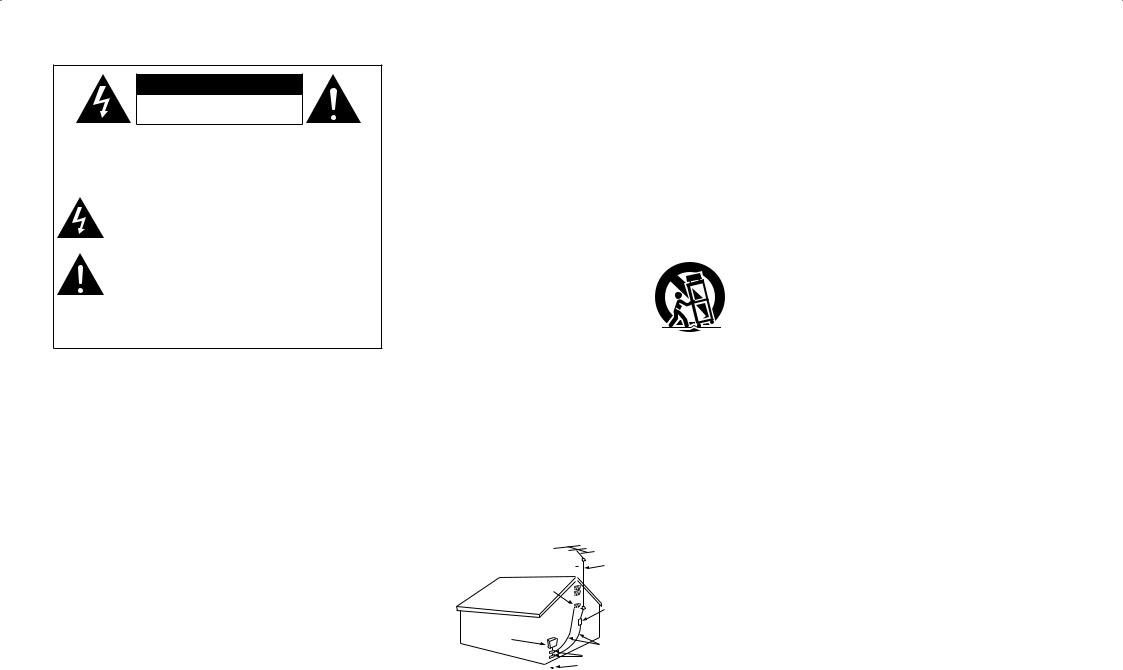
nSAFETY PRECAUTIONS
CAUTION
RISK OF ELECTRIC SHOCK
DO NOT OPEN
CAUTION:
TO REDUCETHE RISK OF ELECTRIC SHOCK, DO NOT REMOVE
COVER (OR BACK). NO USER-SERVICEABLE PARTS INSIDE. REFER SERVICING TO QUALIFIED SERVICE PERSONNEL.
The lightning flash with arrowhead symbol, within an equilateral triangle, is intended to alert the user to the presence of uninsulated “dangerous voltage” within the product’s enclosure that may be of sufficient magnitude to constitute a risk of electric shock to persons.
The exclamation point within an equilateral triangle is intended to alert the user to the presence of important operating and maintenance (servicing) instructions in the literature
accompanying the appliance.
WARNING:
TO REDUCE THE RISK OF FIRE OR ELECTRIC SHOCK, DO NOT EXPOSE THIS APPLIANCE TO RAIN OR MOISTURE.
SAFETY INSTRUCTIONS
1. |
Read Instructions – All the safety and operating instructions should be read |
13. |
Power-Cord Protection – Power-supply cords should be routed so that they |
||||||
|
before the product is operated. |
|
|
|
are not likely to be walked on or pinched by items placed upon or against |
||||
2. |
Retain Instructions – The safety and operating instructions should be |
|
them, paying particular attention to cords at plugs, convenience receptacles, |
||||||
|
retained for future reference. |
|
|
|
and the point where they exit from the product. |
||||
3. |
Heed Warnings – All warnings on the product and in the operating |
15. |
Outdoor Antenna Grounding – If an outside antenna or cable system is |
||||||
|
instructions should be adhered to. |
|
|
|
connected to the product, be sure the antenna or cable system is grounded |
||||
4. |
Follow Instructions – All operating and use instructions should be followed. |
|
so as to provide some protection against voltage surges and built-up static |
||||||
5. |
Cleaning – Unplug this product from the wall outlet before cleaning. Do not |
|
charges. Article 810 of the National Electrical Code, ANSI/NFPA 70, provides |
||||||
|
use liquid cleaners or aerosol cleaners. |
|
|
|
information with regard to proper grounding of the mast and supporting |
||||
6. |
Attachments – Do not use attachments not recommended by the product |
|
structure, grounding of the lead-in wire to an antenna discharge unit, size |
||||||
|
manufacturer as they may cause hazards. |
|
of grounding conductors, location of antenna-discharge unit, connection to |
||||||
7. |
Water and Moisture – Do not use this product near water – for example, |
|
grounding electrodes, and requirements for the grounding electrode. See |
||||||
|
near a bath tub, wash bowl, kitchen sink, or laundry tub; in a wet basement; |
|
Figure A. |
||||||
|
or near a swimming pool; and the like. |
|
|
16. |
Lightning – For added protection for this product during a lightning storm, |
||||
8. |
Accessories – Do not place this product on an unstable cart, stand, tripod, |
|
or when it is left unattended and unused for long periods of time, unplug it |
||||||
|
bracket, or table. The product may fall, causing serious injury to a child or |
|
from the wall outlet and disconnect the antenna or cable system. This will |
||||||
|
adult, and serious damage to the product. Use only with a cart, stand, |
|
prevent damage to the product due to lightning and power-line surges. |
||||||
|
tripod, bracket, or table recommended by the manufacturer, or sold with the |
17. |
Power Lines – An outside antenna system should not be located in the |
||||||
|
product. Any mounting of the product should |
|
vicinity of overhead power lines or other electric light or power circuits, or |
||||||
|
follow the manufacturer’s instructions, and should |
|
where it can fall into such power lines or circuits. When installing an outside |
||||||
|
use a mounting accessory recommended by the |
|
antenna system, extreme care should be taken to keep from touching such |
||||||
|
manufacturer. |
|
|
|
power lines or circuits as contact with them might be fatal. |
||||
9. |
A product and cart combination should be moved |
18. |
Overloading – Do not overload wall outlets, extension cords, or integral |
||||||
|
with care. Quick stops, excessive force, and |
|
convenience receptacles as this can result in a risk of fire or electric shock. |
||||||
|
uneven surfaces may cause the product and cart |
19. |
Object and Liquid Entry – Never push objects of any kind into this product |
||||||
|
combination to overturn. |
|
|
|
through openings as they may touch dangerous voltage points or short-out |
||||
10. |
Ventilation – Slots and openings in the cabinet are provided for ventilation |
|
parts that could result in a fire or electric shock. Never spill liquid of any kind |
||||||
|
and to ensure reliable operation of the product and to protect it from |
|
on the product. |
||||||
|
overheating, and these openings must not be blocked or covered. The |
20. |
Servicing – Do not attempt to service this product yourself as opening or |
||||||
|
openings should never be blocked by placing the product on a bed, sofa, |
|
removing covers may expose you to dangerous voltage or other hazards. |
||||||
|
rug, or other similar surface. This product should not be placed in a built-in |
|
Refer all servicing to qualified service personnel. |
||||||
|
installation such as a bookcase or rack unless proper ventilation is provided |
21. |
Damage Requiring Service – Unplug this product from the wall outlet |
||||||
|
or the manufacturer’s instructions have been adhered to. |
|
and refer servicing to qualified service personnel under the following |
||||||
11. |
Power Sources – This product should be operated only from the type of |
|
conditions: |
||||||
|
power source indicated on the marking label. If you are not sure of the type |
|
a) When the power-supply cord or plug is damaged, |
||||||
|
of power supply to your home, consult your product dealer or local power |
|
b) If liquid has been spilled, or objects have fallen into the product, |
||||||
|
company. For products intended to operate from battery power, or other |
|
c) If the product has been exposed to rain or water, |
||||||
|
sources, refer to the operating instructions. |
|
d) If the product does not operate normally by following the operating |
||||||
12. |
Grounding or Polarization – This product may be equipped with a polarized |
|
instructions. Adjust only those controls that are covered by the operating |
||||||
|
alternating-current line plug (a plug having one blade wider than the other). |
|
instructions as an improper adjustment of other controls may result in |
||||||
|
This plug will fit into the power outlet only one way. This is a safety feature. |
|
damage and will often require extensive work by a qualified technician to |
||||||
|
If you are unable to insert the plug fully into the outlet, try reversing the |
|
restore the product to its normal operation, |
||||||
|
plug. If the plug should still fail to fit, contact your electrician to replace your |
|
e) If the product has been dropped or damaged in any way, and |
||||||
|
obsolete outlet. Do not defeat the safety purpose of the polarized plug. |
|
f) When the product exhibits a distinct change in performance – this |
||||||
|
|
|
|
|
|
|
|
|
indicates a need for service. |
|
FIGURE A |
|
|
22. |
Replacement Parts – When replacement parts are required, be sure the |
||||
|
EXAMPLE OF ANTENNA GROUNDING |
|
|
|
service technician has used replacement parts specified by the manufacturer |
||||
|
AS PER NATIONAL |
|
|
|
|||||
|
"/5&//" |
|
|||||||
|
ELECTRICAL CODE |
|
or have the same characteristics as the original part. Unauthorized |
||||||
|
|
|
|
|
|
-&"% */ |
|
||
|
|
|
|
|
|
8*3& |
|
substitutions may result in fire, electric shock, or other hazards. |
|
|
(306/% |
|
|
|
|
|
|||
|
|
|
|
|
23. |
Safety Check – Upon completion of any service or repairs to this product, |
|||
|
$-".1 |
|
|
|
|
|
|||
|
|
|
|
|
|
"/5&//" |
|
ask the service technician to perform safety checks to determine that the |
|
|
|
|
|
|
|
|
product is in proper operating condition. |
||
|
|
|
|
|
|
%*4$)"3(& 6/*5 |
24. |
||
|
|
|
|
|
|
||||
|
|
|
|
|
|
/&$ 4&$5*0/ |
Wall or Ceiling Mounting – The product should be mounted to a wall or |
||
|
&-&$53*$ |
|
|
|
|
|
|
|
ceiling only as recommended by the manufacturer. |
|
4&37*$& |
|
|
|
|
/&$ 4&$5*0/ |
25. |
Heat – The product should be situated away from heat sources such as |
|
|
&26*1.&/5 |
|
|
|
|
||||
|
|
|
|
|
|
(306/%*/( $0/%6$5034 |
|
|
|
|
|
|
|
|
|
(306/% $-".14 |
|
radiators, heat registers, stoves, or other products (including amplifiers) that |
|
|
|
|
|
|
|
108&3 4&37*$& (306/%*/( |
|
produce heat. |
|
|
|
|
|
|
|
|
|||
|
|
|
|
|
|
|
|||
|
/&$ /"5*0/"- &-&$53*$"- $0%& |
&-&$530%& 4:45&. |
|
|
|||||
|
/&$ "35 1"35 ) |
|
|
||||||
I

FCC INFORMATION (For US customers)
1.PRODUCT
This product complies with Part 15 of the FCC Rules. Operation is subject to the following two conditions: (1) this product may not cause harmful interference, and (2) this product must accept any interference received, including interference that may cause undesired operation.
2.IMPORTANT NOTICE: DO NOT MODIFY THIS PRODUCT
This product, when installed as indicated in the instructions contained in this manual, meets FCC requirements. Modification not expressly approved by DENON may void your authority, granted by the FCC, to use the product.
3.NOTE
This product has been tested and found to comply with the limits for a Class B digital device, pursuant to Part 15 of the FCC Rules. These limits are designed to provide reasonable protection against harmful interference in a residential installation.
This product generates, uses and can radiate radio frequency energy and, if not installed and used in accordance with the instructions, may cause harmful interference to radio communications. However, there is no guarantee that interference will not occur in a particular installation. If this product does cause harmful interference to radio or television reception, which can be determined by turning the product OFF and ON, the user is encouraged to try to correct the interference by one or more of the following measures:
•Reorient or relocate the receiving antenna.
•Increase the separation between the equipment and receiver.
•Connect the product into an outlet on a circuit different from that to which the receiver is connected.
•Consult the local retailer authorized to distribute this type of product or an experienced radio/TV technician for help.
This Class B digital apparatus complies with Canadian ICES-003.
Cet appareil numérique de la classe B est conforme à la norme NMB-003 du Canada.
nNOTE ON USE / OBSERVATIONS RELATIVES A L’UTILISATION
•Avoid high temperatures.
Allow for sufficient heat dispersion when installed in a rack.
•Eviter des températures élevées.
Tenir compte d’une dispersion de chaleur suffisante lors de l’installation sur une étagère.
•Handle the power cord carefully.
Hold the plug when unplugging the cord.
•Manipuler le cordon d’alimentation avec précaution.
Tenir la prise lors du débranchement du cordon.
•Keep the unit free from moisture, water, and dust.
•Protéger l’appareil contre l’humidité, l’eau et la poussière.
•Unplug the power cord when not using the unit for long periods of time.
•Débrancher le cordon d’alimentation lorsque l’appareil n’est pas utilisé pendant de longues périodes.
*(For apparatuses with ventilation holes)
•Do not obstruct the ventilation holes.
•Ne pas obstruer les trous d’aération.
•Do not let foreign objects into the unit.
•Ne pas laisser des objets étrangers dans l’appareil.
•Do not let insecticides, benzene, and thinner come in contact with the unit.
•Ne pas mettre en contact des insecticides, du benzène et un diluant avec l’appareil.
•Never disassemble or modify the unit in any way.
•Ne jamais démonter ou modifier l’appareil d’une manière ou d’une autre.
II
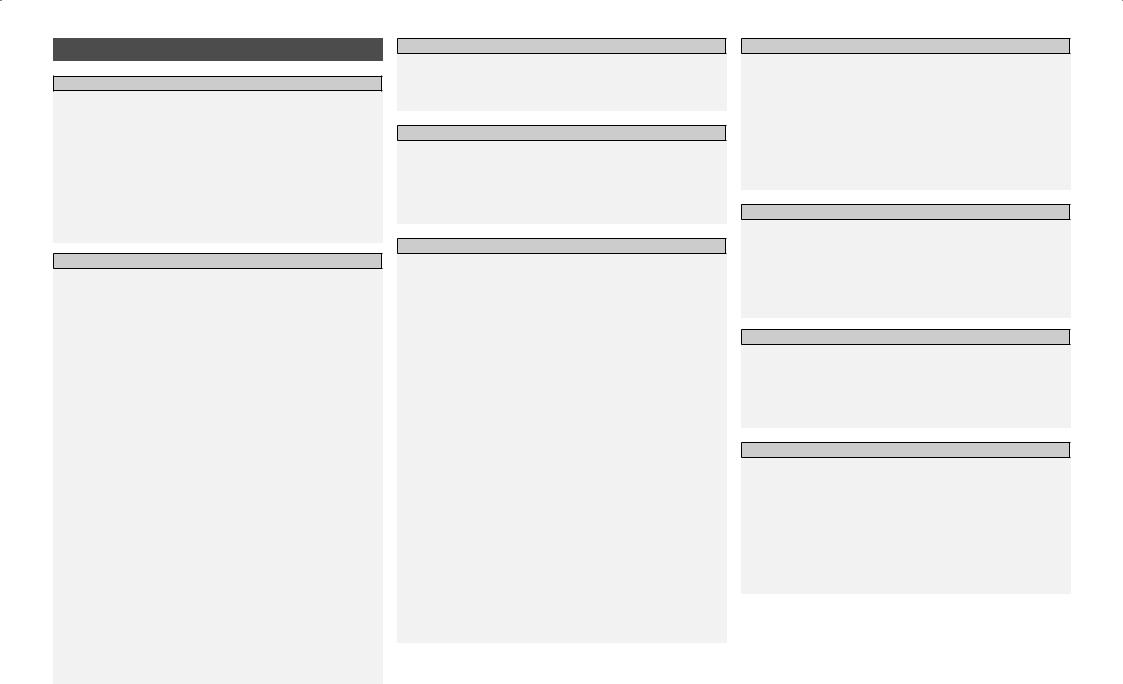
Contents
Getting Started
Accessories······················································································2
Cautions on Handling·····································································3
Cautions on Installation·································································3
About the Remote Control Unit·····················································3
Inserting the Batteries····································································3
Operating Range of the Remote Control Unit································3
Part Names and Functions·····························································4
Front Panel······················································································4 Display····························································································4 Rear Panel·······················································································5 Remote Control Unit·······································································6
Connections
Preparations·····················································································7
Cables Used for Connections·························································7 Video Conversion Function·····························································8
On-Screen Display for Component Video Outputs and
HDMI Output··················································································8 Speaker Connections······································································9
Speaker Installation········································································9 Speaker Connections································································ 9, 10
Connecting Equipment with HDMI connectors························· 11
Connecting the Monitor······························································· 12 Connecting the Playback Components······································· 12 DVD Player···················································································· 12 Record Player················································································ 13 CD Player······················································································ 13 iPod®····························································································· 14 TV/CABLE Tuner············································································ 14 Satellite Receiver·········································································· 15 Connecting the Recording Components····································· 15 Digital Video Recorder·································································· 15 Video Cassette Recorder······························································ 16 CD Recorder / MD Recorder / Tape Deck······································ 16 Connections to Other Devices····················································· 17 Video Camera / Game Console····················································· 17 Component with Multi-channel Output connectors····················· 17 External Power Amplifier······························································ 17 XM connector···············································································18 Antenna terminals ·······································································18
Multi-zone····················································································· 19 External Controller········································································ 19 Connecting the Power Cord·························································20
Once Connections are Completed···············································20
Menu Operations
Operations·····················································································20
Example of Display of Default Values··········································21
Examples of On-screen Display and Front Display····················21
Menu Map······················································································22
Auto Setup
Preparations···················································································23
Auto Setup·····················································································24
aStart Menu··············································································24 Error Messages·······································································25
s Option······················································································25
d Parameter Check·····································································25
Manual Setup
Speaker Setup···············································································26
a Speaker Configuration·····························································26
s Subwoofer Setup·····································································26
d Distance············································································26, 27
fChannel Level··········································································27
gCrossover Frequency·······························································27 HDMI Setup···················································································27
aHDMI Audio Setup···································································27
sHDMI Video Setup···································································28 Audio Setup···················································································28
aEXT. IN Subwoofer Level·························································28
s2ch Direct/Stereo·······························································28, 29
dDolby Digital Setup··································································29
fAuto Surround Mode·······························································29
gManual EQ···············································································29 Zone Setup····················································································30
aZONE2 Setup···········································································30
sZONE3 Setup···········································································30 Option Setup·················································································31
aAmp Assign·············································································31
sVolume Control········································································31
dSource Delete··········································································31
fOn-Screen Display·····························································31, 32
gQuick Select Name··································································32
hTrigger Out···············································································32
jRemote ID Setup·····································································32
k2Way Remote··········································································32
lDisplay·····················································································32 A0Setup Lock···············································································33
Input Setup
Settings Related to Playing Input Sources·································34
Auto Preset···················································································34 Preset Skip···················································································34 Preset Name·················································································34 Input Mode···················································································34 Rename························································································34
Assign···························································································35 iPod·························································································35, 36 Other····························································································36 Antenna Aiming············································································36
Surround Modes
Standard Playback········································································36
Surround Playback of 2-channel Sources································36, 37 Playing Multi-channel Sources (Dolby Digital, DTS, etc.)··············37 DSP Simulation Playback·····························································37
Stereo Playback·············································································37
Direct Playback··············································································37
Playback in the PURE DIRECT Mode···········································38
Parameter
a Surround Parameter···························································38 ~ 40
s Tone Control···············································································40
d Room EQ····················································································40
fRESTORER·················································································41
gNight Mode················································································41
hAudio Delay················································································41
Information
Status·····························································································41
a Main zone················································································41
s ZONE2 / ZONE3······································································41
Audio Input Signal········································································42
HDMI Information··········································································42
a HDMI Signal Information·························································42
s HDMI Monitor Information······················································42
Auto Surround Mode····································································42
Quick Select···················································································42
Preset Station················································································42
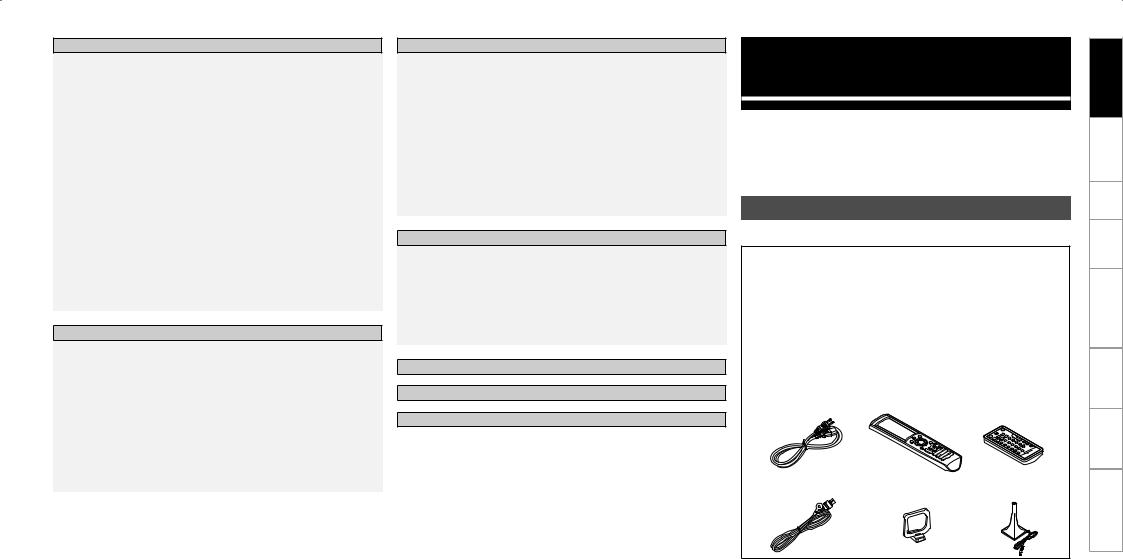
Playback
Preparations···················································································43
Turning the Power On···································································43 Selecting the input source····························································43 Operations During Playback··························································43 Playing Video and Audio Equipment···········································44
Basic Operation············································································44
Listening to FM/AM Broadcasts··················································44
Basic Operation············································································44
Presetting Radio Stations (Preset Memory)·································44
Listening to Preset Stations·························································44 Listening to XM Satellite Radio Programs··································45
Basic Operation············································································45
Checking the XM Signal Strength and Radio ID···························46 Searching Categories····································································46 Accessing XM Radio Stations Directly·········································46 iPod® Playback··············································································47
Basic Operation············································································47
Listening to Music···································································47, 48 Viewing Still Pictures or Videos on the iPod·································48
Other Operations and Functions
Other Operations··········································································48
Playing Super Audio CDs······························································48 Recording on an External Device (REC OUT mode)·····················49 Convenient Functions···································································50
Channel Level···············································································50
Fader Function··············································································50 Quick Select Function···································································50 Personal Memory Plus Function···················································50 Last Function Memory·································································50 Backup Memory···········································································50
Resetting the Microprocessor······················································50
Remote Control Unit Operations
Main Remote Control Unit···························································51
Operating DENON Audio Components········································51
Presetting·····················································································51
Operating Preset Components·············································51 ~ 53
Setting the Remote ID··································································54
Learning Function·········································································54
System Call Function····································································55
Punch Through Function································································55
Setting the Time the Backlight Stays Lit·······································55
Adjusting the Backlight’s Brightness·············································56
Resetting the Main Remote Control Unit·····································56
Sub Remote Control Unit Operations·········································56
Amp Assign / Multi-zone Connections and Operations
Multi-zone Settings with the Amp Assign Function··········57 ~ 59 Multi-zone Settings and Operations with Zone Pre-out Output·····59
Multi-zone Operations··································································60
Turning the Power On and Off······················································60 Selecting the Input Source···························································60
Adjusting the Volume····································································60 Turning off the Sound Temporarily················································60
Other Information································································61 ~ 69
Troubleshooting···································································70 ~ 72
Specifications··············································································· 73
List of preset codes············································ End of this manual
Getting Started
Thank you for purchasing this DENON product. To ensure proper operation, please read these owner’s manual carefully before using the product.
After reading them, be sure to keep them for future reference.
Accessories
Check that the following parts are supplied with the product.
q Owner’s manual....................................................................... |
|
|
1 |
w Warranty (for North America model only)................................. |
|
1 |
|
e Service station list.................................................................... |
|
|
1 |
r Power cord (Cord length: Approx. 7-31/64 ft /1.9 m)................ |
|
1 |
|
t Main remote control (RC-1068)................................................ |
|
|
1 |
y LR6/AA batteries (for RC-1068). |
............................................... |
|
2 |
u Sub remote control (RC-1071).................................................. |
|
|
1 |
i R03/AAA batteries (for RC-1071).............................................. |
|
2 |
|
o FM indoor antenna................................................................... |
|
|
1 |
Q0AM loop antenna...................................................................... |
|
|
1 |
Q1Setup microphone (Cord length: Approx. 25 ft / 7.6 m)............ |
1 |
||
r |
t |
u |
|
o |
Q0 |
Q1 |
Troubleshooting Information Zone-Multi Control Remote Playback Setup Connections Started Getting
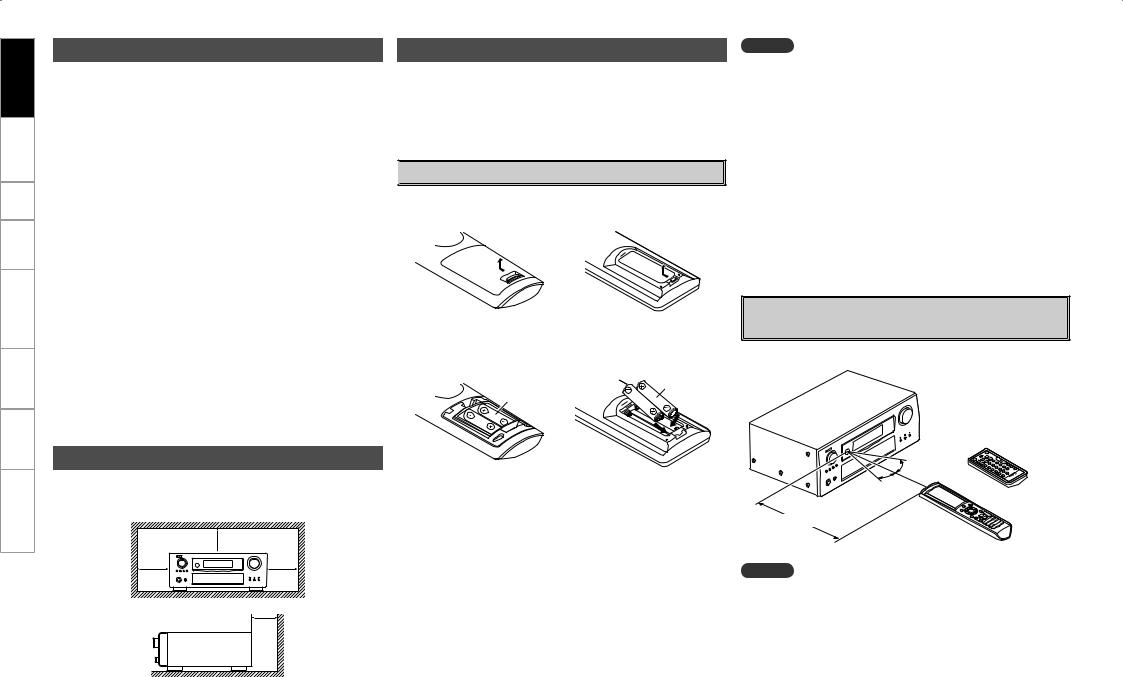
Troubleshooting Information Zone-Multi Control Remote Playback Setup Connections Started Getting
Cautions on Handling
•Before turning the power switch on
Check once again that all connections are correct and that there are no problems with the connection cables.
•Power is supplied to some of the circuitry even when the unit is set to the standby mode. When traveling or leaving home for long periods of time, be sure to unplug the power cord from the power outlet.
•About condensation
If there is a major difference in temperature between the inside of the unit and the surroundings, condensation (dew) may form on the operating parts inside the unit, causing the unit not to operate properly.
If this happens, let the unit sit for an hour or two with the power turned off and wait until there is little difference in temperature before using the unit.
•Cautions on using mobile phones
Using a mobile phone near this unit may result in noise. If so, move the mobile phone away from this unit when it is in use.
•Moving the unit
Turn off the power and unplug the power cord from the power outlet.
Next, disconnect the connection cables to other system units before moving the unit.
•Note that the illustrations in these instructions may differ from the actual unit for explanation purposes.
About the Remote Control Unit
In addition to the AVR-2808CI, the included main remote control unit (RC-1068) can also be used to operate the equipment listed below. q DENON system components
wNon-DENON system components
•By setting the preset memory (vpage 51 ~ 53)
•By using the learn function (vpage 54)

 Inserting the Batteries
Inserting the Batteries
q Lift the clasp and remove the rear lid.
(RC-1068) |
(RC-1071) |
w Load the two batteries properly as indicated by the marks in the battery compartment.
(RC-1068) |
(RC-1071) |
R03/AAA
LR6/AA
NOTE
•Replace the batteries with new ones if the set does not operate even when the remote control unit is operated close to the unit.
•The supplied batteries are only for verifying operation.
•When inserting the batteries, be sure to do so in the proper direction, following the “q” and “w” marks in the battery compartment.
•To prevent damage or leakage of battery fluid:
•Do not use a new battery together with an old one.
•Do not use two different types of batteries.
•Do not attempt to charge dry batteries.
•Do not short-circuit, disassemble, heat or dispose of batteries in flames.
•If the battery fluid should leak, carefully wipe the fluid off the inside of the battery compartment and insert new batteries.
•Remove the batteries from the remote control unit if it will not be in use for long periods.
•When replacing the batteries, have the new batteries ready and insert them as quickly as possible.
Operating Range of the Remote Control
Unit
Point the remote control unit at the remote sensor when operating it.
Cautions on Installation
Note:
For proper heat dispersal, do not install this unit in a confined e Put the rear cover back on. space, such as a bookcase or similar enclosure.
|
b Note |
b |
b |
b |
Wall |
(RC-1071)
|
30° |
30° |
or |
Approx. 23 feet / 7 m
(RC-1068)
NOTE
The set may function improperly or the remote control unit may not operate if the remote control sensor is exposed to direct sunlight, strong artificial light from an inverter type fluorescent lamp or infrared light.

Part Names and Functions
For buttons not explained here, see the page indicated in parentheses ( ).

 Front Panel
Front Panel
o i u |
y |
|
|
t |
|||||||||||
|
|
|
|
|
|
|
|
|
|
|
|
|
|
|
|
|
|
|
|
|
|
|
|
|
|
|
|
|
|
|
|
|
|
|
|
|
|
|
|
|
|
|
|
|
|
|
|
|
|
|
|
|
|
|
|
|
|
|
|
|
|
|
|
|
|
|
|
|
|
|
|
|
|
|
|
|
|
|
|
|
|
|
|
|
|
|
|
|
|
|
|
|
|
|
|
|
|
|
|
|
|
|
|
|
|
|
|
|
|
|
|
|
|
|
|
|
|
|
|
|
|
|
|
|
|
|
|
Display |
|
|
|
|
|
|
|
|
Q6 |
Q5 |
Q4 |
Q3 |
Q0i |
u |
y |
|
Q2Q1o |
||||||
q |
w |
|
|
e |
|
|
r t |
Q0Q1Q2 Q3
q w e |
r |
GWith the door openH
E4E3E2E1E0W9 |
W8W7W6W5W4 |
|
Q4 Q5Q6Q7Q8Q9W0W1 |
W2 |
|
q Power operation button (ON/STANDBY)············································ (43)
w Power indicator··········································· (43) e Power switch (hON jOFF)······················ (43) r QUICK SELECT buttons / indicators·········· (50)
tMASTER VOLUME control knob················ (43)
yMaster volume indicator
uDisplay
i Remote control sensor································· (3) o SOURCE SELECT knob······························· (43) Q0SOURCE button··········································· (43) Q1TUNING PRESET button····························· (44)
Q2ZONE2/3 / REC SELECT button··········· (49, 60)
Q3VIDEO SELECT button································ (35)
Q4Headphones jack (PHONES)······················· (43)
Q5ZONE2 ON/OFF button······························· (60)
Q6ZONE3 ON/OFF button······························· (60)
Q7INPUT MODE button··································· (34)
Q8MENU button·············································· (20)
Q9Cursor buttons (uio p)··························· (20)
W0CH SEL / ENTER button························ (20, 50)
W1RETURN button··········································· (20)
W2V.AUX INPUT connectors··························· (17)
W3SETUP MIC jack··········································· (23)
W4ROOM EQ button········································ (40)
W5DIMMER button··········································· (32)
W6SPEAKER button········································· (43)
W7SURROUND BACK button·························· (40)
W8STATUS button············································ (42)
W9AUDIO DELAY button·································· (41)
E0RESTORER button······································· (41)
E1DIRECT/STEREO button····························· (37)
E2PURE DIRECT button·································· (38)
E3DSP SIMULATION button··························· (37)
E4STANDARD button······································ (36)
q Input signal indicators
w Input signal channel indicators
These light when digital signals are input.
e Information display
The input source name, surround mode, setting values and other information are displayed here.
r Output signal channel indicators
t Front speaker indicator
These light according to the settings of the front A and B speakers.
y Master volume indicator
u AUDYSSEY MULTEQ XT indicator
This lights when the room equalizer is selected.
i Recording output source indicator
This lights when the REC OUT mode is selected.
o NIGHT indicator
This lights when the night mode is selected.
Q0Multi-zone indicators
These light when the power for the respective zone is turned on.
Q1RESTORER indicator
This lights when the RESTORER mode is selected.
Q2AL24 indicator
This lights when AL24 Processing Plus is activated (vpage 63).
Q3Input mode indicators
Q4HDMI indicator
This lights when playing using HDMI connections.
Q5Decoder indicators
These light when the respective decoders are operating.
Q6Tuner reception mode indicators
These light according to the reception conditions when the input source is set to “TUNER”.
•AUTO
These light when in the auto tuning mode.
•STEREO
In the FM mode, these light when receiving analog stereo broadcasts.
•TUNED
Lights when the broadcast is properly tuned in.
Troubleshooting Information Zone-Multi Control Remote Playback Setup Connections Started Getting
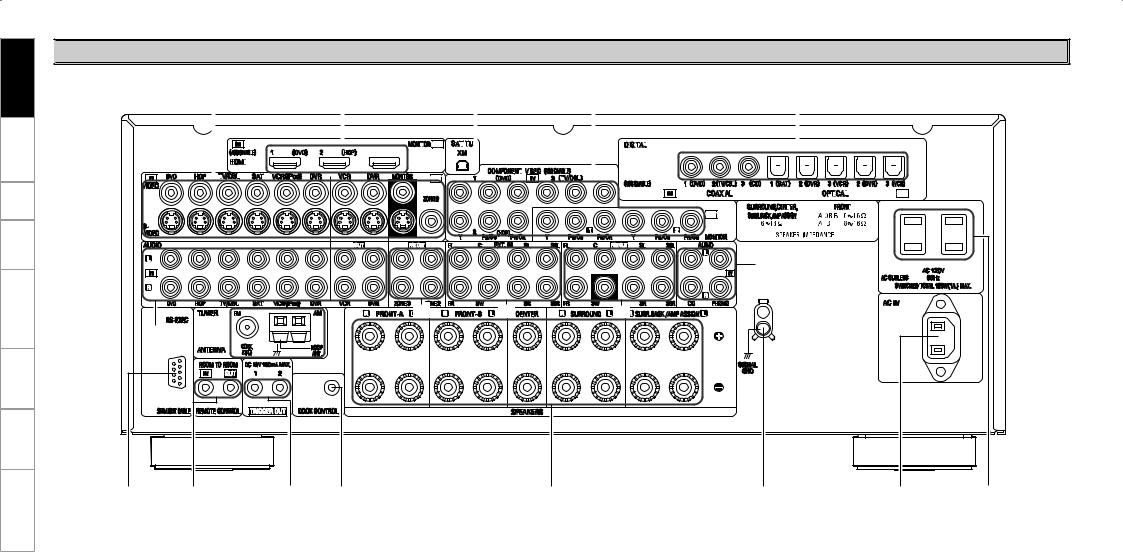
Troubleshooting Information Zone-Multi Control Remote Playback Setup Connections Started Getting

 Rear Panel
Rear Panel
|
Q3 |
|
|
|
|
|
|
|
Q2 |
|
|
|
|
|
|
|
|
|
|
|
|
Q1 |
|
|
|
|
|
|
|
Q0 |
|
|
|
|
|
|
|
|
|
|
|
|
|
|
|
|
|
|
|
|
|
|
|
|
|
|
|
|
|
|
|
|
o |
|
|
|
||||||||||||||||||||||||||||||||||||||||||||||||||
|
|
|
|
|
|
|
|
|
|
|
|
|
|
|
|
|
|
|
|
|
|
|
|
|
|
|
|
|
|
|
|
|
|
|
|
|
|
|
|
|
|
|
|
|
|
|
|
|
|
|
|
|
|
|
|
|
|
|
|
|
|
|
|
|
|
|
|
|
|
|
|
|
|
|
|
|
|
|
|
|
|
|
|
|
|
|
|
|
|
|
|
|
|
|
|
|
|
|
|
|
|
|
|
|
|
|
|
|
|
|
|
|
|
|
|
|
|
|
|
|
|
|
|
|
|
|
|
|
|
|
|
|
|
|
|
|
|
|
|
|
|
|
|
|
|
|
|
|
|
|
|
|
|
|
|
|
|
|
|
|
|
|
|
|
|
|
|
|
|
|
|
|
|
|
|
|
|
|
|
|
|
|
|
|
|
|
|
|
|
|
|
|
|
|
|
|
|
|
|
|
|
|
|
|
|
|
|
|
|
|
|
|
|
|
|
|
|
|
|
|
|
|
|
|
|
|
|
|
|
|
|
|
|
|
|
|
|
|
|
|
|
|
|
|
|
|
|
|
|
|
|
|
|
|
|
|
|
|
|
|
|
|
|
|
|
|
|
|
|
|
|
|
|
|
|
|
|
|
|
|
|
|
|
|
|
|
|
|
|
|
|
|
|
|
|
|
|
|
|
|
|
|
|
|
|
|
|
|
|
|
|
|
|
|
|
|
|
|
|
|
|
|
|
|
|
|
|
|
|
|
|
|
|
|
|
|
|
|
|
|
|
|
|
|
|
|
|
|
|
|
|
|
|
|
|
|
|
|
|
|
|
|
|
|
|
|
|
|
|
|
|
|
|
|
|
|
|
|
|
|
|
|
|
|
|
|
|
|
|
|
|
|
|
|
|
|
|
|
|
|
|
|
|
|
|
|
|
|
|
|
|
|
|
|
|
|
|
|
|
|
|
|
|
|
|
|
|
|
|
|
|
|
|
|
|
|
|
|
|
|
|
|
|
|
|
|
|
|
|
|
|
|
|
|
|
|
|
|
|
|
|
|
|
|
|
|
|
|
|
|
|
|
|
|
|
|
|
|
|
|
|
|
|
|
|
|
|
|
|
|
|
|
|
|
|
|
|
|
|
|
|
|
|
|
|
|
|
|
|
|
|
|
|
|
|
|
|
|
|
|
|
|
|
|
|
|
|
|
|
|
|
|
|
|
|
|
|
|
|
|
|
|
|
|
|
|
|
|
|
|
|
|
|
|
|
|
|
|
|
|
|
|
|
|
|
|
|
|
|
|
|
|
|
|
|
|
|
|
|
|
|
|
|
|
|
|
|
|
|
|
|
|
|
|
|
|
|
|
|
|
|
|
|
|
|
|
|
|
|
|
|
|
|
|
|
|
|
|
|
|
|
|
|
|
|
|
|
|
|
|
|
|
|
|
|
|
|
|
|
|
|
|
|
|
|
|
|
|
|
|
|
|
|
|
|
|
|
|
|
|
|
|
|
|
|
|
|
|
|
|
|
|
|
|
|
|
|
|
|
|
|
|
|
|
|
|
|
|
|
|
|
|
|
|
|
|
|
|
|
|
|
|
|
|
|
|
Q4 |
|
|
|
|
|
Q6 |
Q7 |
Q6 |
|
|
Q4 |
Q5 |
|
|
|
|
|
|
q |
w |
e |
r |
t |
y |
u |
i |
q RS-232C connector······································ (19) w REMOTE CONTROL jacks··························· (19) e TRIGGER OUT jacks···································· (19) r DOCK CONTROL jack·································· (14) t Speaker terminals (SPEAKERS)··················· (9) y SIGNAL GND terminal································ (13) u AC inlet (AC IN)··········································· (20)
i AC OUTLETS················································ (20)
o Digital audio connectors
(OPTICAL / COAXIAL)··························· (12, 15)
Q0COMPONENT VIDEO connectors··············· (12)
Q1XM connector (SAT TU)······························ (18)
Q2HDMI connectors··········································(11)
Q3VIDEO / S-VIDEO connectors····················· (12)
Q4Analog audio connectors (AUDIO)············ (12)
Q5FM/AM antenna terminals
(TUNER ANTENNA)····································· (18) Q6PRE OUT connectors······························ (17, 19) Q7EXT. IN connectors······································ (17)


 Remote Control Unit
Remote Control Unit
n Main remote control unit (RC-1068)
Q5
q |
w


 Q6 e
Q6 e

Q7
r |
|
|
t |
Q8 |
|
y |
Q9 |
|
u |
W0 |
|
i |
||
W1 |
||
|
||
o |
W2 |
|
|
||
Q0 |
|
|
Q1 |
W3 |
|
W4 |
||
Q2 |
||
|
Q3 

 W5
W5
W6
Q4

 W7
W7
q Signal transmission indicator···················· (51) w Mode select buttons··································· (51) e Quick select / System call buttons······ (50, 55) r Surround mode buttons·····················(36 ~ 38) t System buttons····································· (52, 53) y Audio delay button (A. DL)························· (41) u Tuner system buttons································· (44) i Input mode button (INPUT)······················· (34) o MENU button·············································· (20) Q0Cursor buttons (uio p)·························· (20)
Q1Parameter / Search button
(PARA / SRCH)································· (38, 46, 48) Q2HOME button··············································· (51) Q3Channel buttons (CH)································· (44)
Q4Input source select / Number buttons··· (43, 44) Q5Remote control signal transmitter·············· (3) Q6Device select indicators (DEV1 / DEV2)···· (51)
Q7ZONE3 select indicators (Z3)······················ (51)
Q8RESTORER button (RSTR)·························· (41)
Q9Night button (NGT)····································· (41)
W0Test tone button (TEST)······························ (27)
W1Front speaker select button (SPKR)··········· (43)
W2POWER buttons··········································· (43)
W3Channel select (CH SEL) /
ENTER button········································ (20, 50) W4Return button (RTN)···································· (20)
W5Master volume control buttons (VOL)······· (43)
W6Muting button (MUTE)························· (43, 60)
W7Main remote control unit setup button
(RC SETUP)·················································· (51)
The time for which the backlight stays on can be changed (vpage 55 “Setting the Time the Backlight Stays Lit”).
NOTE
•The M. SEL, DTU, NET/USB buttons cannot be used.
•The NET/DTU and ZONE2 mode QUICK SELECT (1 ~ 3), A. DL, RSTR, NGT, INPUT, SPKR, TEST and
surround mode buttons cannot be used.
• The ZONE4 mode cannot be used.
n Sub remote control unit (RC-1071)
q
 i
i
w


 o
o



 Q0
Q0

 Q1
Q1
e |
|
r |
Q2 |
|
|
t |
Q3 |
|
|
y |
Q4 |
u |
|
q Remote control signal transmitter·············· (3) w Zone power off button (OFF)····················· (60) e CHANNEL buttons······································ (56) r TUNING buttons········································· (56)
tSystem buttons··········································· (56)
yREPEAT button············································ (56)
uRANDOM button········································· (56)
iZONE2/ZONE3 select switch····················· (56)
oZone power on button (ON)······················· (60) Q0Input source select buttons························ (60)
Q1Volume control buttons (VOLUME)··········· (60)
Q2Muting button (MUTE)······························· (60)
Q3SHIFT button··············································· (56)
Q4FAVORITES DIRECT PLAY button··············· (56)
Troubleshooting Information Zone-Multi Control Remote Playback Setup Connections Started Getting
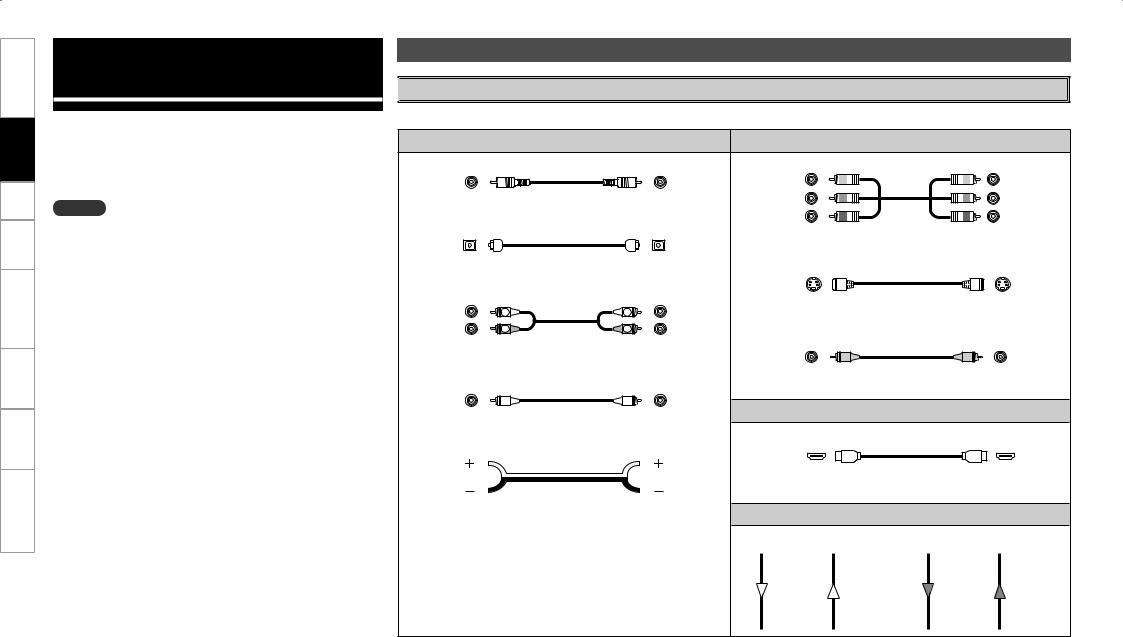
Troubleshooting Information Zone-Multi Control Remote Playback Setup Connections Started Getting
Connections
Connections for all compatible audio and video signal formats are described in these operating instructions. Please select the types of connections suited for the equipment you are connecting.
With some types of connections, certain settings must be made on the AVR-2808CI. For details, refer to the instructions for the respective connection items below.
NOTE
•Do not plug in the power cord until all connections have been completed.
•When making connections, also refer to the operating instructions of the other components.
•Be sure to connect the left and right channels properly (left with left, right with right).
•Do not bundle power cords together with connection cables. Doing so can result in humming or noise.
Preparations

 Cables Used for Connections
Cables Used for Connections
Select the cables according to the equipment being connected.
|
Audio cables |
|
|
Video cables |
|
|
Coaxial digital connections |
|
Component video connections |
|
|||
(Orange) |
|
|
(Green) |
|
|
(Y) |
|
|
|
|
|
|
|
|
Coaxial digital (75 Ω/ohms pin-plug) cable |
(Blue) |
|
|
(PB/CB) |
|
Optical digital connections |
|
(Red) |
|
|
(PR/CR) |
|
|
|
Component video cable |
|
|||
|
|
|
|
|
||
|
Optical cable |
|
S-Video connections |
|
|
|
Analog connections (stereo) |
|
|
|
|
|
|
(White) |
L |
L |
|
|
S-Video cable |
|
|
|
|
|
|||
(Red) |
R |
R |
Video connections |
|
|
|
|
|
|
|
|
||
|
Stereo pin-plug cable |
|
(Yellow) |
|
|
|
|
|
|
|
|
|
|
Analog connections (monaural, for subwoofer) |
|
75 Ω/ohms pin-plug video cable |
|
|||
(Black) |
|
|
|
Audio and video cables |
|
|
|
Pin-plug cable |
|
|
|
||
|
|
HDMI connections |
|
|
||
|
|
|
|
|
||
Speaker connections |
|
|
|
|
|
|
|
|
|
|
19-pin HDMI cable |
|
|
|
Speaker cables |
|
|
Signal direction |
|
|
|
|
|
|
|
||
|
|
|
Audio signal: |
|
Video signal: |
|
|
|
|
Output |
Input |
Output |
Input |
Input |
Output |
Input |
Output |
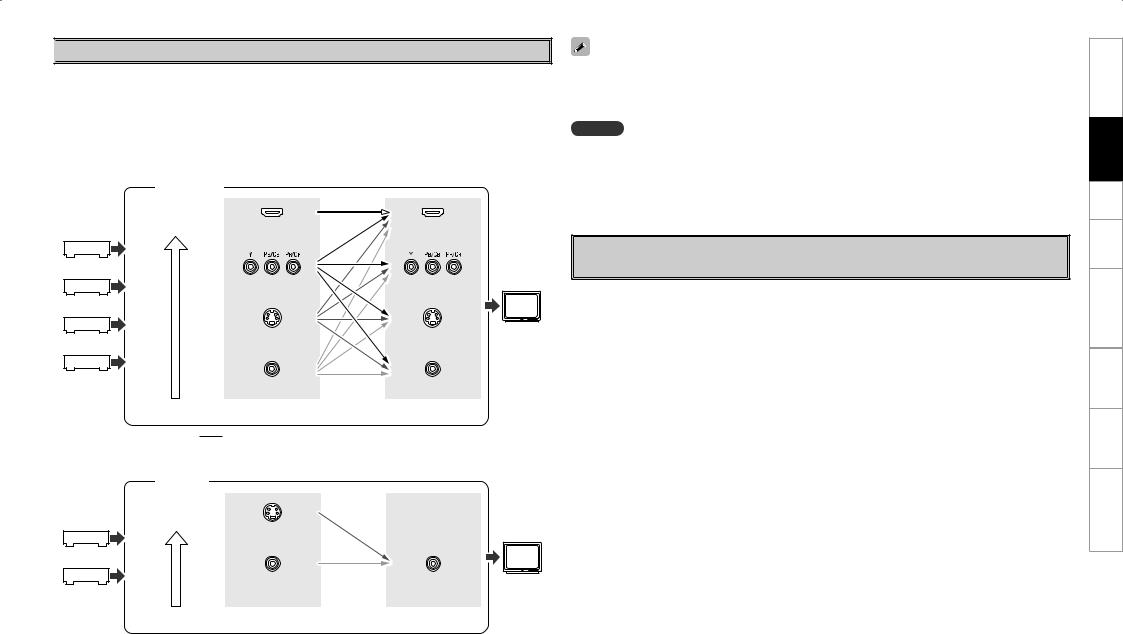

 Video Conversion Function
Video Conversion Function
•This function automatically converts various formats of video signals input to the AVR-2808CI into the format used to output the video signals from the AVR-2808CI to a monitor.
•The AVR-2808CI’s video input/output circuitry is compatible with the following four types of video signals:
Digital video signals: HDMI
Analog video signals: Component video, S-Video and Video
GFlow of video signals inside the AVR-2808CIH |
|
||
Main zone |
|
|
|
High picture |
HDMI connector |
HDMI connector |
|
quality playback |
|
||
|
Component video |
Component video |
Monitor |
|
connectors |
connectors |
|
|
S-Video connector |
S-Video connector |
|
|
Video connector |
Video connector |
|
|
Video inputs |
Video outputs |
|
|
: When 480i/576i signals are input in the main zone |
|
|
|
GFlow of video signals for ZONE2H |
|
|
ZONE2 |
|
|
|
High picture |
|
|
|
quality playback |
S-Video connector |
|
ZONE2 |
|
|
monitor |
|
|
|
|
|
|
Video connector |
Video connector |
|
|
Video inputs |
Video outputs |
|
•When not using this function, connect a monitor output with the same type of connector as the video input connector.
•The resolution of the HDMI input-compatible monitor connected to the AVR-2808CI can be checked at menu “Information” – “HDMI Signal Information” – “HDMI Monitor Information” (vpage 42).
NOTE
•HDMI signals cannot be converted into analog signals.
•1080p component input video signals cannot be output to anything other than component video connectors.
•480p/576p, 1080i and 720p component video input signals cannot be converted into S-Video or Video format.
On-Screen Display for Component Video Outputs and HDMI Output
•When viewing HDMI or component video signals via the AVR-2808CI, the on-screen display appears when the MENU button or the main remote control unit´s PARA button is operated.
•When only HDMI or component video signals are input to the AVR-2808CI, the characters of the onscreen display are not displayed over the picture.
Troubleshooting Information Zone-Multi Control Remote Playback Setup Connections Started Getting

Troubleshooting Information Zone-Multi Control Remote Playback Setup Connections Started Getting
Speaker Connections

 Speaker Installation
Speaker Installation
The illustration below shows a basic example of installation of the amplifier combined with 8 speakers and a monitor.
Subwoofer |
Center speaker |
Surround back speakers
Front speakers |
|
|
Place the front speakers to the |
|
|
Surround speakers |
||
sides of the monitor or screen and |
||
|
||
as flush with the screen surface as |
|
|
possible. |
|
The table below shows a typical speaker configuration for the AVR-2808CI.
|
FRONT |
CENTER |
SURROUND |
SURROUND BACK |
SUBWOOFER |
|||||
|
L |
R |
L |
R |
L |
R |
1 only |
|||
7.1-channels |
S |
S |
S |
S |
S |
S |
S |
– |
S |
|
(FRONT A+B) |
||||||||||
|
|
|
|
|
|
|
|
|
||
7.1-channels |
S |
S |
S |
S |
S |
S |
S |
– |
S |
|
6.1-channels |
S |
S |
S |
S |
S |
– |
– |
S |
S |
|
5.1-channels |
S |
S |
S |
S |
S |
– |
– |
– |
S |
|
3.1-channels |
S |
S |
S |
– |
– |
– |
– |
– |
S |
|
2.1-channels |
S |
S |
– |
– |
– |
– |
– |
– |
S |
|
2-channels |
S |
S |
– |
– |
– |
– |
– |
– |
– |
|

 Speaker Connections
Speaker Connections
Example: 5.1-channels (FRONT A+B) and ZONE2 use
Front speakers |
Front speakers |
Center speaker |
Subwoofer |
||||||||
|
|
A |
|
|
|
B |
|
||||
|
|
|
|
|
|
|
|
|
|
|
Subwoofer |
|
|
|
|
|
|
|
|
|
|
|
with built-in |
(L) |
|
|
(R) |
|
(L) |
|
(R) |
|
|
|
amplifier |
|
|
|
|
|
|
|
|
||||
w |
q |
w |
q |
w |
q |
w |
q |
w |
q |
|
|
|
|
|
|
|
|
|
|
|
*/ |
||
b L : Left |
|
|
|
|
|
|
|
|
|
|
|
R : Right |
|
|
|
|
|
|
|
|
|
|
|
|
|
|
(L) |
(R) |
|
|
|
|
(L) |
|
(R) |
|
|
|
w |
q w |
q |
|
|
|
w |
q w |
q |
Surround speakers |
|
ZONE2 speakers |
|
|
|
ZONE2
When using just one surround back speaker, connect it to the left channel (SBL).
NOTE
By default, the AVR-2808CI’s “Amp Assign” setting is set to “ZONE2”. To use as the surround back speaker for the main zone, change the “Amp Assign” setting (vpage 31).
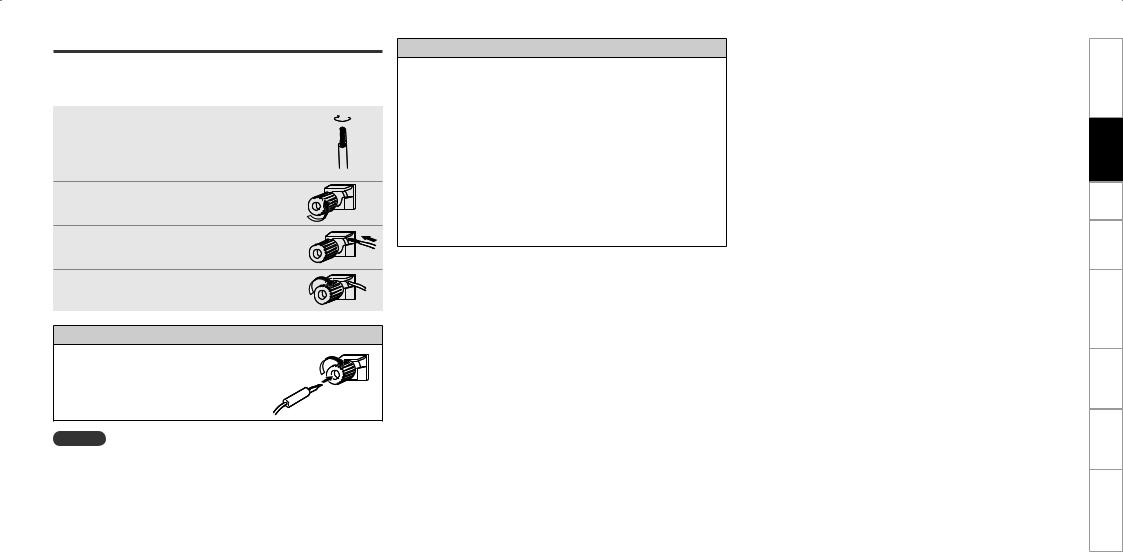
Connecting the Speaker Cables
Carefully check the left (L) and right (R) channels and + (red) and – (black) polarities on the speakers being connected to the AVR-2808CI, and be sure to interconnect the channels and polarities correctly.
1Peel off about 0.03 ft/10 mm of sheathing from the tip of the speaker cable, then either twist the core wire tightly or terminate it.
Turn |
the |
speaker |
terminal |
2counterclockwise to loosen it. |
|
||
3Insert the speaker cable’s core wire to the hilt into the speaker terminal.
4Turn the speaker terminal clockwise to tighten it.
When using a banana plug
Tighten the speaker terminal firmly before inserting the banana plug.
NOTE
•Use speakers with an impedance of 6 to 16 Ω/ohms. When using front A and B speakers simultaneously, use speakers with an impedance of 8 to 16 Ω/ohms.
•Connect the speaker cables in such a way that they do not stick out of the speaker terminals. The protection circuit may be activated if the core wires touch the rear panel or if the + and – sides touch each other (v “Protection circuit”).
•Never touch the speaker terminals while the power supply is connected. Doing so could result in electric shock.
Protection circuit
If speakers with an impedance lower than specified (for example 4 Ω/ohms speakers) are used for an extended period of time with the volume turned up high, the temperature may rise, activating the protection circuit.
When the protection circuit is activated, the speaker output is shut off and the power indicator flashes red. If this happens, unplug the power cord, then check the speaker cable and input cable connections. If the set is extremely hot, wait for it to cool off and improve ventilation around it. Once this is done, plug the power cord back in and turn the set's power back on.
If the protection circuit is activated again even though there are no problems in the ventilation around the set nor in the connections, the set may be damaged. Turn the power off, then contact a DENON service center.
Troubleshooting Information Zone-Multi Control Remote Playback Setup Connections Started Getting
10
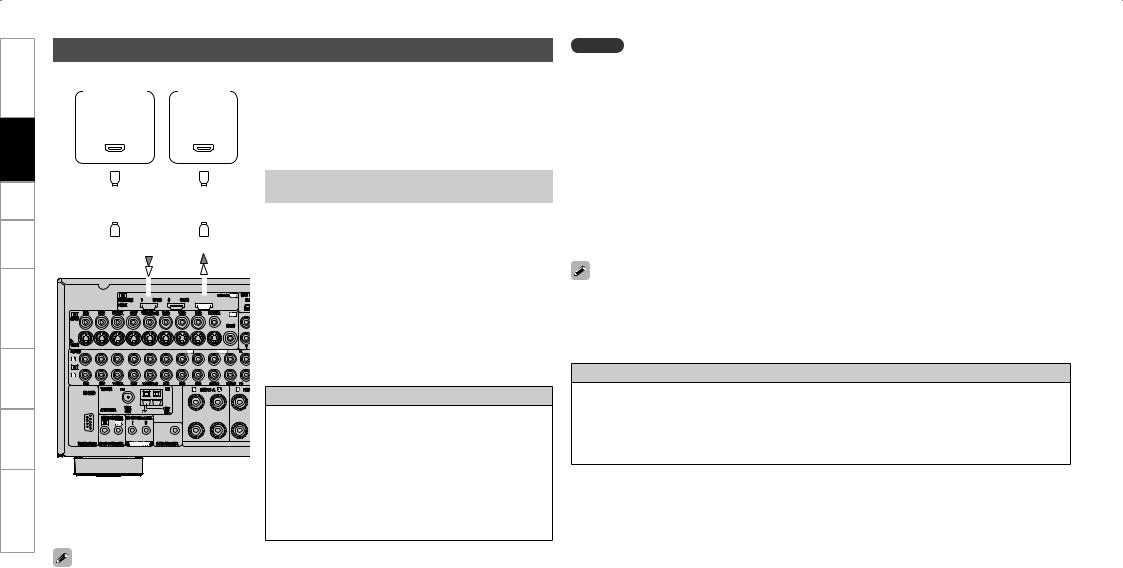
Troubleshooting Information Zone-Multi Control Remote Playback Setup Connections Started Getting
Connecting Equipment with HDMI connectors
With HDMI connections, the video and audio signals can be transferred with a single cable.
|
|
|
DVD player |
Monitor |
|
)%.* |
|
)%.* |
065 |
|
*/ |
b The AVR-2808CI is equipped for HDMI version 1.3a. This version is compatible with other versions, allowing connection to all components equipped with an HDMI connector.
b The AVR-2808CI is compatible with 30and 36-bit Deep Color.
|
|
|
|
|
|
|
|
|
|
|
|
|
|
|
|
|
|
|
|
Compatible |
Details |
Discs |
|
|
|
|
|
|
|
|
|
|
|
|
|
|
|
|
|
|
|
|
|||
|
|
|
|
|
|
|
|
|
|
|
|
|
|
|
|
|
|
|
|
audio format |
(examples) |
|
|
|
|
|
|
|
|
|
|
|
|
|
|
|
|
|
|
|
|
|
|||
|
|
|
|
|
|
|
|
|
|
|
|
|
|
|
|
|
|
|
|
|
||
|
|
|
|
|
|
|
|
|
|
|
|
|
|
|
|
|
|
|
|
|
|
|
|
|
|
|
|
|
|
|
|
|
|
|
|
|
|
|
|
|
|
|
2-channel linear |
2ch 32-192 kHz |
CD, DVD-Video, |
|
|
|
|
|
|
|
|
|
|
|
|
|
|
|
|
|
|
|
|
PCM |
16/20/24 bits |
DVD-Audio |
|
|
|
|
|
|
|
|
|
|
|
|
|
|
|
|
|
|
|
||||
|
|
|
|
|
|
|
|
|
|
|
|
|
|
|
|
|
|
|
||||
|
|
|
|
|
|
|
|
|
|
|
|
|
|
|
|
|
|
|
|
|
|
|
|
|
|
|
|
|
|
|
|
|
|
|
|
|
|
|
|
|
|
|
Multi-channel |
8ch 32-192 kHz |
DVD-Audio |
|
|
|
|
|
|
|
|
|
|
|
|
|
|
|
|
|
|
|
||||
|
|
|
|
|
|
|
|
|
|
|
|
|
|
|
|
|
|
|
|
linear PCM |
16/20/24 bits |
|
|
|
|
|
|
|
|
|
|
|
|
|
|
|
|
|
|
|
|
|
|
||
|
|
|
|
|
|
|
|
|
|
|
|
|
|
|
|
|
|
|
|
|
|
|
|
|
|
|
|
|
|
|
|
|
|
|
|
|
|
|
|
|
|
|
Dolby Digital, DTS |
Bitstream |
DVD-Video |
|
|
|
|
|
|
|
|
|
|
|
|
|
|
|
|
|
|
|
|
|
|
|
|
|
|
|
|
|
|
|
|
|
|
|
|
|
|
|
|
|
|
|
|
2/5.1ch |
|
|
|
|
|
|
|
|
|
|
|
|
|
|
|
|
|
|
|
|
|
DSD |
2.8224 MHz |
SACD |
|
|
|
|
|
|
|
|
|
|
|
|
|
|
|
|
|
|
|
|
|
1 bit |
|
|
|
|
|
|
|
|
|
|
|
|
|
|
|
|
|
|
|
|
|
|
|
|
|
|
|
|
|
|
|
|
|
|
|
|
|
|
|
|
|
|
|
|
|
|
|
|
|
|
|
|
|
|
|
|
|
|
|
|
|
|
|
|
|
|
|
|
|
|
|
|
|
|
|
|
|
|
|
|
|
|
|
|
|
|
|
|
|
|
Dolby Digital Plus, |
|
HD DVD, |
|
|
|
|
|
|
|
|
|
|
|
|
|
|
|
|
|
|
|
|
|||
|
|
|
|
|
|
|
|
|
|
|
|
|
|
|
|
|
|
|
|
|||
|
|
|
|
|
|
|
|
|
|
|
|
|
|
|
|
|
|
|
|
Dolby TrueHD, |
Bitstream |
|
|
|
|
|
|
|
|
|
|
|
|
|
|
|
|
|
|
|
|
|
Blu-ray Disc |
||
|
|
|
|
|
|
|
|
|
|
|
|
|
|
|
|
|
|
|
|
DTS-HD |
|
|
|
|
|
|
|
|
|
|
|
|
|
|
|
|
|
|
|
|
|
|
|
|
|
|
|
|
|
|
|
|
|
|
|
|
|
|
|
|
|
|
|
|
|
|
|
|
|
|
|
|
|
|
|
|
|
|
|
|
|
|
|
|
|
|
|
|
|
|
|
|
|
|
|
|
|
|
|
|
|
|
|
|
|
|
|
|
|
|
|
|
|
|
Copyright protection system (HDCP)
In order to play the digital video and audio signals of a DVDVideo or DVD-Audio disc using HDMI/DVI connections, both the connected DVD player and monitor must be equipped for a copyright protection system called “HDCP” (Highbandwidth Digital Content Protection).
HDCP is a copy protection technology consisting of data encoding and mutual identification of the devices.
The AVR-2808CI is HDCP-compatible. For details on the DVD player or monitor you are using, refer to its operating instructions.
•By default, the HDMI audio signals are output from the speakers connected to the AVR-2808CI.
•To output the sound from the TV, make the settings at menu “Manual Setup” – “HDMI Setup” – “HDMI Audio Setup” – “TV” (vpage 27).
NOTE
•Use a CPPM-compatible DVD player to play DVD-Audio discs that are copyright-protected by CPPM.
•The AVR-2808CI cannot be controlled from another device via the HDMI cable.
•The audio signals output from the HDMI connector (sampling frequency, bit rate, etc.) may be restricted by the connected device.
•Video signals are not output properly when using devices that are not HDCP-compatible.
•Video signals are not output if the input video signals do not match the monitor’s resolution. In this case, switch the DVD player’s resolution to a resolution with which the monitor is compatible.
•If the menu “Manual Setup” – “HDMI Setup” – “HDMI Audio Setup” setting (vpage 27) is set to
“AMP”, the sound may be interrupted when the monitor’s power is turned off.
•Use a cable on which the HDMI logo is indicated (a certified HDMI product) for connection to the HDMI connector. Normal playback may not be possible when using a cable other than one on which the HDMI logo is indicated (a non-HDMI-certified product).
•If the monitor or DVD player does not support deep color, deep color signal transfer is not possible.
•If the monitor or DVD player does not support xvYCC, xvYCC signal transfer is not possible.
•If the monitor does not support “Auto Lipsync Correction” function, this function will not work.
•When the AVR-2808CI and DVD player are connected using an HDMI cable, also connect the AVR-2808CI and monitor using an HDMI cable.
•If the connected monitor or DVD player only has a DVI-D connector, use an HDMI/DVI converter cable. When using a DVI cable, no audio signals are transmitted.
•Use a Deep Color compatible cable for connection to Deep Color compatible devices.
When connecting with an HDMI/DVI converter cable (adapter)
•HDMI video signals are theoretically compatible with the DVI format.
When connecting to a monitor, etc., equipped with a DVI-D connector, connection is possible using an HDMI/DVI converter cable, but depending on the combination of components in some cases the video signals will not be output.
•When connecting using an HDMI/DVI converter adapter, the video signals may not be output properly due to poor connections with the connected cable, etc.
11

Connecting the Monitor
•Connect the cables to be used (vpage 8 “Video Conversion Function”).
•With HDMI connections, the video and audio signals can be transferred with a single cable.
•To output the audio signals to the monitor with HDMI connections, set menu “Manual Setup” – “HDMI Setup” – “HDMI Audio Setup” to “TV” (vpage 27).
Monitor
|
|
|
|
|
|
|
|
|
|
|
|
|
|
|
|
|
|
|
|
|
|
|
|
|
|
|
|
|
|
|
|
|
|
|
7*%&0 |
|
|
|
|
|
|
|
|
|
|
|
|
|
|
|
|
|
|
|
|
|
|
|
|
|
|
|
|
|
|
|
|
|
||||||||
|
|
|
|
|
|
|
|
|
|
|
|
|
|
|
|
|
|
|
|
|
|
|
|
|
|
|
|
|
|
|
|
|
|
|
|
|
|
|
|
|
|
|
|
|
|
|
|
|
|
|
|
|
|
|
|
|
|
|
|
|
|
|
|
|
|
|
|
|||||||||
|
|
|
|
|
|
|
|
|
|
|
|
|
|
|
|
|
|
)%.* |
|
|
|
|
|
|
7*%&0 |
|
|
|
|
4 7*%&0 |
|
$0.10/&/5 7*%&0 |
|
|
|
|
|
|
|
|
|
|
|
|
|
|
|
|
|
|
|
|
|
|
|
|
|
|||||||||||||||||||
|
|
|
|
|
|
|
|
|
|
|
|
|
|
|
|
|
|
*/ |
|
|
|
|
*/ |
|
|
|
|
|
*/ |
|
|
|
|
|
*/ |
|
|
|
|
|
|
|
|
|
|
|
|
|
|
|
|
|
|
|
|
|
|
|
|
|
|
|
|
|
||||||||||||
|
|
|
|
|
|
|
|
|
|
|
|
|
|
|
|
|
|
|
|
|
|
|
|
|
|
|
|
|
|
|
|
|
|
|
|
|
|
|
|
|
|
|
: 1# 13 |
|
|
|
|
|
|
|
|
|
|
|
|
|
|
|
|
|
|
|
|
|
|
|
|
|
|
|||||||
|
|
|
|
|
|
|
|
|
|
|
|
|
|
|
|
|
|
|
|
|
|
|
|
|
|
|
|
|
|
|
|
|
|
|
|
|
|
|
|
|
|
|
|
|
|
|
|
|
|
|
|
|
|
|
|
|
|
|
|
|
|
|
|
|
|
|
|
|
|
|
|
|
|
|
|
|
|
|
|
|
|
|
|
|
|
|
|
|
|
|
|
|
|
|
|
|
|
|
|
|
|
|
|
|
|
|
|
|
|
|
|
|
|
|
|
|
|
|
|
|
|
|
|
|
|
|
|
|
|
|
|
|
|
|
|
|
|
|
|
|
|
|
|
|
|
|
|
|
|
|
|
|
|
|
|
|
|
|
|
|
|
|
|
|
|
|
|
|
|
|
|
|
|
|
|
|
|
|
|
|
|
|
|
|
|
|
|
|
|
|
|
|
|
|
|
|
|
|
|
|
|
|
|
|
|
|
|
|
|
|
|
|
|
|
|
|
|
|
|
|
|
|
|
|
|
|
|
|
|
|
|
|
|
|
|
|
|
|
|
|
|
|
|
|
|
|
|
|
|
|
|
|
|
|
|
|
|
|
|
|
|
|
|
|
|
|
|
|
|
|
|
|
|
|
|
|
|
|
|
|
|
|
|
|
|
|
|
|
|
|
|
|
|
|
|
|
|
|
|
|
|
|
|
|
|
|
|
|
|
|
|
|
|
|
|
|
|
|
|
|
|
|
|
|
|
|
|
|
|
|
|
|
|
|
|
|
|
|
|
|
|
|
|
|
|
|
|
|
|
|
|
|
|
|
|
|
|
|
|
|
|
|
|
|
|
|
|
|
|
|
|
|
|
|
|
|
|
|
|
|
|
|
|
|
|
|
|
|
|
|
|
|
|
|
|
|
|
|
|
|
|
|
|
|
|
|
|
|
|
|
|
|
|
|
|
|
|
|
|
|
|
|
|
|
|
|
|
|
|
|
|
|
|
|
|
|
|
|
|
|
|
|
|
|
|
|
|
|
|
|
|
|
|
|
|
|
|
|
|
|
|
|
|
|
|
|
|
|
|
|
|
|
|
|
|
|
|
|
|
|
|
|
|
|
|
|
|
|
|
|
|
|
|
|
|
|
|
|
|
|
|
|
|
|
|
|
|
|
|
|
|
|
|
|
|
|
|
|
|
|
|
|
|
|
|
|
|
|
|
|
|
|
|
|
|
|
|
|
|
|
|
|
|
|
|
|
|
|
|
|
|
|
|
|
|
|
|
|
|
|
|
|
|
|
|
|
|
|
|
|
|
|
|
|
|
|
|
|
|
|
|
|
|
|
|
|
|
|
|
|
|
|
|
|
|
|
|
|
|
|
|
|
|
|
|
|
|
|
|
|
|
|
|
|
|
|
|
|
|
|
|
|
|
|
|
|
|
|
|
|
|
|
|
|
|
|
|
|
|
|
|
|
|
|
|
|
|
|
|
|
|
|
|
|
|
|
|
|
|
|
|
|
|
|
|
|
|
|
|
|
|
|
|
|
|
|
|
|
|
|
|
|
|
|
|
|
|
|
|
|
|
|
|
|
|
|
|
|
|
|
|
|
|
|
|
|
|
|
|
|
|
|
|
|
|
|
|
|
|
|
|
|
|
|
|
|
|
|
|
|
|
|
|
|
|
|
|
|
|
|
|
|
|
|
|
|
|
|
|
|
|
|
|
|
|
|
|
|
|
|
|
|
|
|
|
|
|
|
|
|
|
|
|
|
|
|
|
|
|
|
|
|
|
|
|
|
|
|
|
|
|
|
|
|
|
|
|
|
|
|
|
|
|
|
|
|
|
|
|
|
|
|
|
|
|
|
|
|
|
|
|
|
|
|
|
|
|
|
|
|
|
|
|
|
|
|
|
|
|
|
|
|
|
|
|
|
|
|
|
|
|
|
|
|
|
|
|
|
|
|
|
|
|
|
|
|
|
|
|
|
|
|
|
|
|
|
|
|
|
|
|
|
|
|
|
|
|
|
|
|
|
|
|
|
|
|
|
|
|
|
|
|
|
|
|
|
|
|
|
|
|
|
|
|
|
|
|
|
|
|
|
|
|
|
|
|
|
|
|
|
|
|
|
|
|
|
|
|
|
|
|
|
|
|
|
|
|
|
|
|
|
|
|
|
|
|
|
|
|
|
|
|
|
|
|
|
|
|
|
|
|
|
|
|
|
|
|
|
|
|
|
|
|
|
|
|
|
|
|
|
|
|
|
|
|
|
|
|
|
|
|
|
|
|
|
|
|
|
|
|
|
|
|
|
|
|
|
|
|
|
|
|
|
|
|
|
|
|
|
|
|
|
|
|
|
|
|
|
|
|
|
|
|
|
|
|
|
|
|
|
|
|
|
|
|
|
|
|
|
|
|
|
|
|
|
|
|
|
|
|
|
|
|
|
|
|
|
|
|
|
|
|
|
|
|
|
|
|
|
|
|
|
|
|
|
|
|
|
|
|
|
|
|
|
|
|
|
|
|
|
|
|
|
|
|
|
|
|
|
|
|
|
|
|
|
|
|
|
|
|
|
|
|
|
|
|
|
|
|
|
|
|
|
|
|
|
|
|
|
|
|
|
|
|
|
|
|
|
|
|
|
|
|
|
|
|
|
|
|
|
|
|
|
|
|
|
|
|
|
|
|
|
|
|
|
|
|
|
|
|
|
|
|
|
|
|
|
|
|
|
|
|
|
|
|
|
|
|
|
|
|
|
|
|
|
|
|
|
|
|
|
|
|
|
|
|
|
|
|
|
|
|
|
|
|
|
|
|
|
|
|
|
|
|
|
|
|
|
|
|
|
|
|
|
|
|
|
|
|
|
|
|
|
|
|
|
|
|
|
|
|
|
|
|
|
|
|
|
|
|
|
|
|
|
|
|
|
|
|
|
|
|
|
|
|
|
|
|
|
|
|
|
|
|
|
|
|
|
|
|
|
|
|
|
|
|
|
|
|
|
|
|
|
|
|
|
|
|
|
|
|
|
|
|
|
|
|
|
|
|
|
|
|
|
|
|
|
|
|
|
|
|
|
|
|
|
|
|
|
|
|
|
|
|
|
|
|
|
|
|
|
|
|
|
|
|
|
|
|
|
|
|
|
|
|
|
|
|
|
|
|
|
|
|
|
|
|
|
|
|
|
|
|
|
|
|
|
|
|
|
|
|
|
|
|
|
|
|
|
|
|
|
|
|
|
|
|
|
|
|
|
|
|
|
|
|
|
|
|
|
|
|
|
|
|
|
|
|
|
|
|
|
|
|
|
|
|
|
|
|
|
|
|
|
|
|
|
|
|
|
|
|
|
|
|
|
|
|
|
|
|
|
|
|
|
|
|
|
|
|
|
|
|
|
|
|
|
|
|
|
|
|
|
|
|
|
|
|
|
|
|
|
|
|
|
|
|
|
|
|
|
|
|
|
|
|
|
|
|
|
|
|
|
|
|
|
|
|
|
|
|
|
|
|
|
|
|
|
|
|
|
|
|
|
|
|
|
|
|
|
|
|
|
|
|
|
|
|
|
|
|
|
|
|
|
|
|
|
|
|
|
|
|
|
|
|
|
|
|
|
|
|
|
|
|
|
|
|
|
|
|
|
|
|
|
|
|
|
|
|
|
|
|
|
|
|
|
|
|
|
|
|
|
|
|
|
|
|
|
|
|
|
|
|
|
|
|
|
|
|
|
|
|
|
|
|
|
|
|
|
|
|
|
|
|
|
|
|
|
|
|
|
|
|
|
|
|
|
|
|
|
|
|
|
|
|
|
|
|
|
|
|
|
|
|
|
|
|
|
|
|
|
|
|
|
|
|
|
|
|
|
|
|
|
|
|
|
|
|
|
|
|
|
|
|
|
|
|
|
|
|
|
|
|
|
|
|
|
|
|
|
|
|
|
|
|
|
|
|
|
|
|
|
|
|
|
|
|
|
|
|
|
|
|
|
|
|
|
|
|
|
|
|
|
|
|
|
|
|
|
NOTE
•The component video connectors may be indicated differently on your monitor. For details, see the monitor’s operating instructions.
•The audio signals output from the HDMI connectors are only the HDMI input signals.
Video-converted HDMI signals are not included in the audio signals. To play the sound by monitor, make analog or digital audio output connections to monitor’s audio input connectors.
Connecting the Playback Components
Carefully check the left (L) and right (R) channels and the inputs and outputs, and be sure to interconnect correctly.

 DVD Player
DVD Player
•Connect the cables to be used.
•With HDMI connections, the video and audio signals can be transferred with a single cable.
DVD player |
|
|
|
|
|
|
|
|
|
|
7*%&0 |
|
|
|
|
"6%*0 |
|
)%.* |
7*%&0 |
4 7*%&0 |
$0.10/&/5 7*%&0 |
"6%*0 |
$0"9*"- |
|||
065 |
065 |
065 |
|
065 |
|
065 |
065 |
|
|
|
|
: |
1# |
13 |
- |
3 |
|
|
|
|
|
|
|
L |
R |
|
|
|
|
|
|
|
L |
R |
|
•Connect an HDP (High-Definition Player) in the same way.
•When using an optical cable for the digital audio connection, make the settings at menu “Input Setup”
– “Assign” – “Digital In” (vpage 35).
Troubleshooting Information Zone-Multi Control Remote Playback Setup Connections Started Getting
12
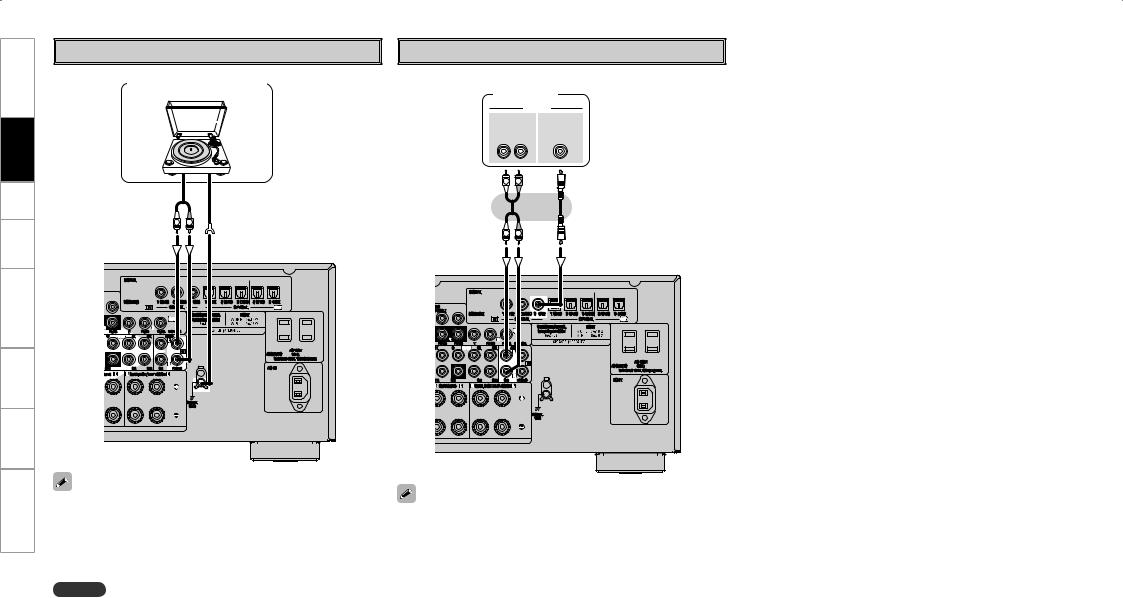
Troubleshooting Information Zone-Multi Control Remote Playback Setup Connections Started Getting
Record Player |
CD Player |
|
|
Turntable (MM cartridge) |
Connect the cables to be used. |
||
CD player |
|||
|
|||
|
|
"6%*0 |
|
|
"6%*0 |
$0"9*"- |
|
|
065 |
065 |
|
|
- 3 |
|
|
|
L |
R |
"6%*0 |
(/% |
|
065 |
|
|
|
|
|
L |
R |
|
|
L |
R |
•When connecting a record player with an MC cartridge, use a commercially available MC head amplifier or a step-up transformer.
•Induction humming (a booming sound) may be produced from the speakers if the volume is raised with no record player connected.
•With some record players, noise may be generated when the ground wire is connected. If so, disconnect the ground wire.
NOTE
When using an optical cable for the digital audio connection, make the settings at menu “Input Setup” – “Assign” – “Digital In” (vpage 35).
The AVR-2808CI’s SIGNAL GND terminal is meant to reduce noise when a record player is connected. This is not a safety ground terminal.
13
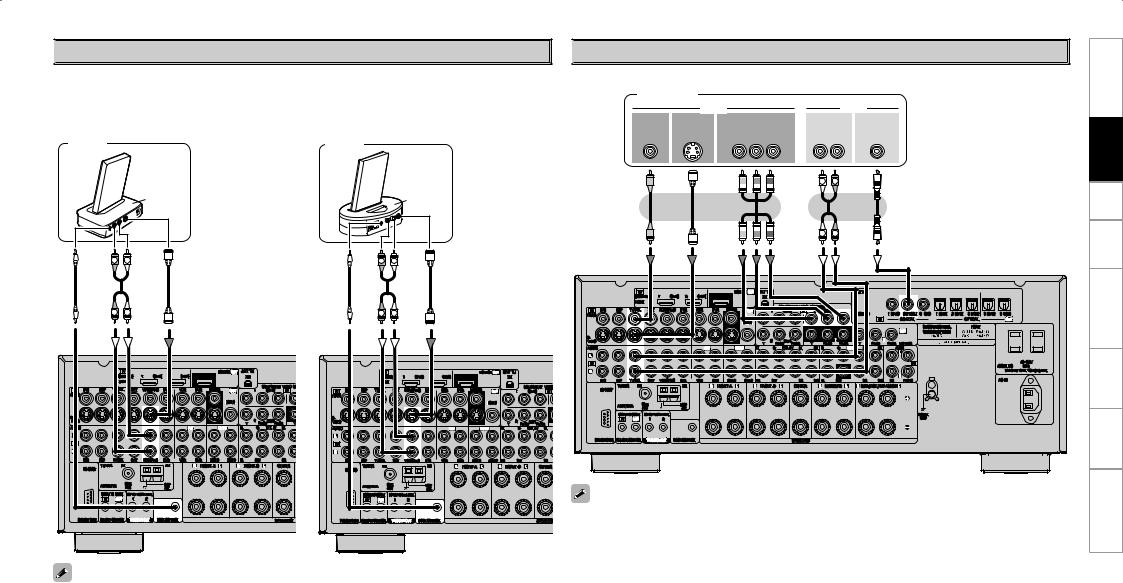

 iPod®
iPod®
Use a DENON Control Dock for iPod (ASD-1R, ASD-3N or ASD-3W, sold separately) to connect the iPod to the AVR-2808CI. For instructions on the Control Dock for iPod settings, refer to the Control Dock for iPod’s operating instructions.
Example 1:
iPod |
|
|
"4% 3 |
R |
L |
R |
L |
Example 2:
iPod |
|
|
"4% / 8 |
R |
L |
R |
L |

 TV/CABLE Tuner
TV/CABLE Tuner
Connect the cables to be used.
TV tuner
|
7*%&0 |
|
|
|
|
"6%*0 |
|
7*%&0 |
4 7*%&0 |
$0.10/&/5 7*%&0 |
"6%*0 |
$0"9*"- |
|||
065 |
065 |
|
065 |
|
065 |
065 |
|
|
|
: |
1# |
13 |
- |
3 |
|
|
|
|
|
|
L |
R |
|
|
|
|
|
|
L |
R |
|
When using an optical cable for the digital audio connection, make the settings at menu “Input Setup”
– “Assign” – “Digital In” (vpage 35).
•With the default settings, the iPod can be used connected to the VCR (iPod) connector.
•To assign the iPod to a connector other than VCR (iPod), make the settings at menu “Input Setup” – “(input source to which iPod dock assigned)” – “Assign” – “iPod dock” (vpage 36).
Troubleshooting Information Zone-Multi Control Remote Playback Setup Connections Started Getting
14
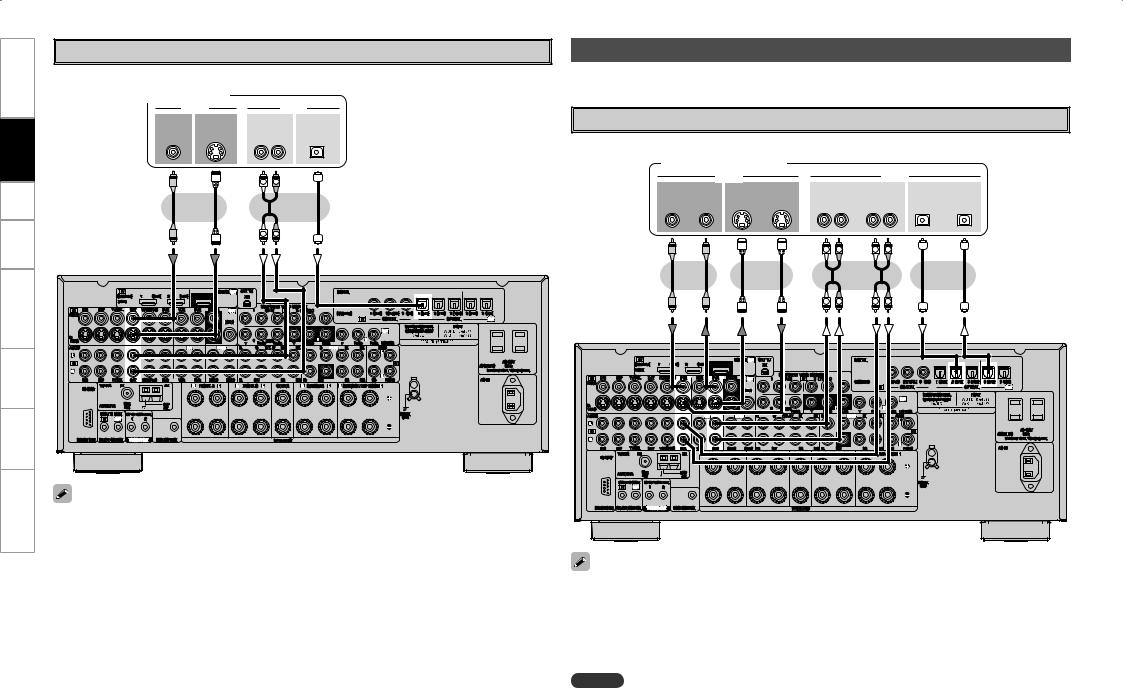
Troubleshooting Information Zone-Multi Control Remote Playback Setup Connections Started Getting
Satellite Receiver |
|
|
|
|
Connecting the Recording Components |
|
||||||
Connect the cables to be used. |
|
|
|
|
Carefully check the left (L) and right (R) channels and the inputs and outputs, and be sure to interconnect |
|||||||
|
|
|
|
correctly. |
|
|
|
|
|
|
|
|
DBS / BS tuner |
|
|
|
|
|
|
|
|
|
|
||
|
|
|
|
|
|
|
|
|
|
|
||
7*%&0 |
|
|
"6%*0 |
Digital Video Recorder |
|
|
|
|
|
|||
7*%&0 |
4 7*%&0 |
"6%*0 |
015*$"- |
|
|
|
|
|
||||
065 |
065 |
065 |
065 |
|
|
|
|
|
|
|
|
|
|
|
- |
3 |
|
Connect the cables to be used. |
|
|
|
|
|
|
|
|
|
|
|
|
|
|
|
|
|
|
||
|
|
|
|
|
Digital video recorder |
|
|
|
|
|
||
|
|
L |
R |
|
|
7*%&0 |
|
|
|
"6%*0 |
|
|
|
|
|
7*%&0 |
|
4 7*%&0 |
|
"6%*0 |
|
|
015*$"- |
||
|
|
|
|
|
|
|
|
|
||||
|
|
|
|
|
065 */ |
*/ |
065 |
*/ |
065 |
065 |
*/ |
|
|
|
|
|
|
|
|
- |
3 |
- |
3 |
|
|
|
|
L |
R |
|
|
|
|
|
|
|
|
|
|
|
|
|
|
|
|
L |
R |
L |
R |
|
|
|
|
|
|
|
|
or |
|
|
|
or |
|
|
L |
R |
L |
R |
• When using a coaxial digital cable for the digital audio connection, make the settings at menu “Input Setup” – “Assign” – “Digital In” (vpage 35).
• When using a component video cable for the video connection, make the settings at menu “Input Setup”
– “Assign” – “Component In” (vpage 36).
• Make analog connections if you wish to record analog audio signals.
• When recording via the AVR-2808CI, the playback device´s cable must be of the same type as the cable used to connect the AVR-2808CI´s DVR OUT connector.
Example: TV IN → S-Video cable : DVR OUT → S-Video cable TV IN →Video cable : DVR OUT →Video cable
• When using a component video cable for the video connection, make the settings at menu “Input Setup”
– “Assign” – “Component In” (vpage 36).
NOTE
Do not connect the output of the component connected to the AVR-2808CI’s OPTICAL2 output connector to any input connector other than OPTICAL2.
15
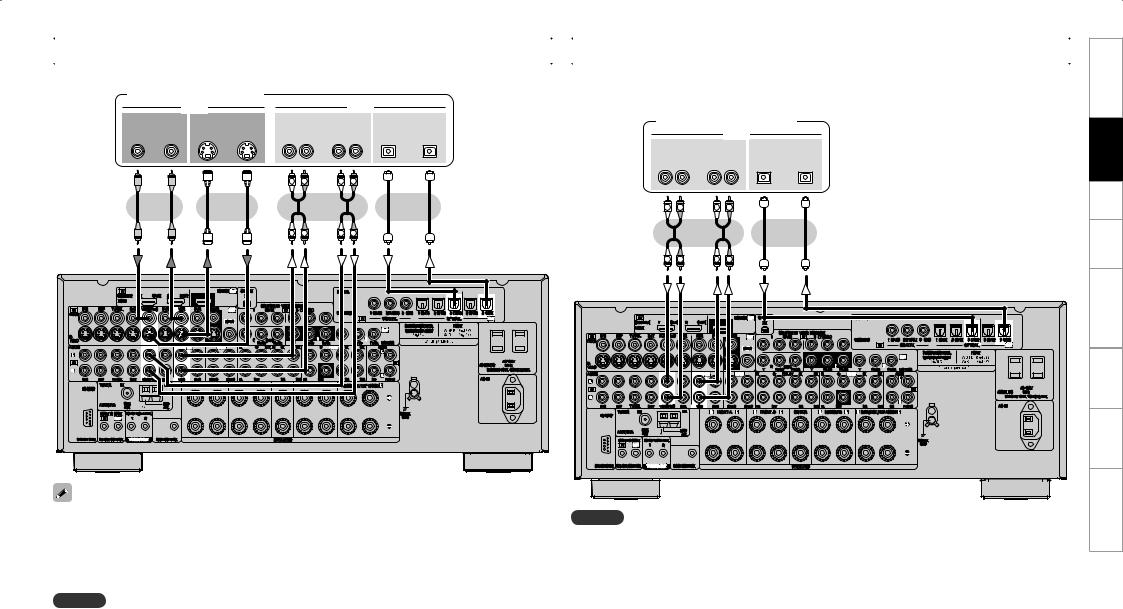
|
Video Cassette Recorder |
|
CD Recorder / MD Recorder / Tape Deck |
Connect the cables to be used. |
Make analog connections if you wish to record analog audio signals, or digital connections if you wish to |
||
|
Video cassette recorder |
record digital audio signals, depending on the types of connectors on the components being used. |
|
|
|
|
|
|
|
7*%&0 |
|
|
|
"6%*0 |
|
CD recorder / |
|
|||
7*%&0 |
|
|
4 7*%&0 |
|
"6%*0 |
|
015*$"- |
MD recorder /Tape deck |
|
|||
065 |
*/ |
*/ |
065 |
*/ |
065 |
065 |
*/ |
|
"6%*0 |
|
||
|
|
|
- |
3 |
- |
3 |
|
|
|
|
||
|
|
|
|
|
"6%*0 |
|
015*$"- |
|
||||
|
|
|
|
|
|
|
|
|
|
|
||
|
|
|
|
|
|
|
|
065 |
*/ |
065 |
*/ |
|
|
|
|
|
|
|
|
|
- |
3 |
- |
3 |
|
|
|
|
L |
R |
L |
R |
|
|
|
|
|
|
|
|
|
|
|
|
|
|
L |
R |
L |
R |
|
|
|
or |
|
|
|
or |
|
|
|
|
|
|
|
|
|
L |
R |
L |
R |
|
|
|
|
|
|
|
|
|
|
|
|
|
|
|
|
|
or |
|
|
|
|
|
|
|
|
|
L |
R |
L |
R |
|
•When recording via the AVR-2808CI, the playback device´s cable must be of the same type as the cable used to connect the AVR-2808CI´s VCR OUT connector.
Example: TV IN → S-Video cable : VCR OUT → S-Video cable TV IN →Video cable : VCR OUT →Video cable
•When using a component video cable for the video connection, make the settings at menu “Input Setup”
– “Assign” – “Component In” (vpage 36).
NOTE
NOTE
Do not connect the output of the component connected to the AVR-2808CI’s OPTICAL3 output connector to any input connector other than OPTICAL3.
Do not connect the output of the component connected to the AVR-2808CI’s OPTICAL3 output connector to any input connector other than OPTICAL3.
Troubleshooting Information Zone-Multi Control Remote Playback Setup Connections Started Getting
16
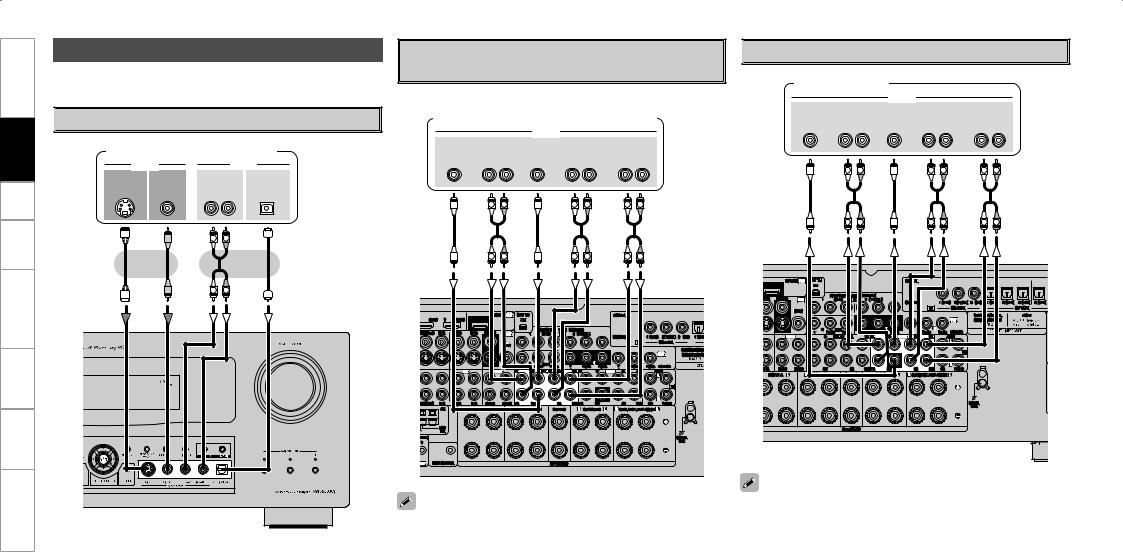
Troubleshooting Information Zone-Multi Control Remote Playback Setup Connections Started Getting
Connections to Other Devices
Carefully check the left (L) and right (R) channels and the inputs and outputs, and be sure to interconnect correctly.

 Video Camera / Game Console
Video Camera / Game Console
Video camera / Game console
7*%&0 |
|
|
|
"6%*0 |
4 7*%&0 |
7*%&0 |
"6%*0 |
015*$"- |
|
065 |
065 |
065 |
065 |
|
|
|
- |
3 |
|
|
|
L |
R |
|
|
|
L |
R |
|
Component with Multi-channel Output connectors
DVD player /
Super Audio CD player / External decoder
|
|
|
"6%*0 |
|
|
|
|
46# |
'30/5 |
$&/5&3 |
463306/% |
463306/% |
|||
800'&3 |
|
|
|
|
|
#"$, |
|
|
- |
3 |
|
- |
3 |
- |
3 |
|
L |
R |
|
L |
R |
L |
R |
|
L |
R |
|
L |
R |
L |
R |

 External Power Amplifier
External Power Amplifier
Power amplifier
|
|
|
"6%*0 |
|
|
|
|
46# |
'30/5 |
$&/5&3 |
463306/% |
463306/% |
|||
800'&3 |
|
|
|
|
|
#"$, |
|
|
- |
3 |
|
- |
3 |
- |
3 |
|
L |
R |
|
L |
R |
L |
R |
|
L |
R |
|
L |
R |
L |
R |
•To play the analog input signals input to the EXT. IN connectors, press the INPUT MODE button on the main unit or INPUT button on the main remote control unit and select “EXT. IN” or make the settings at menu “Input Setup” – “Input Mode” – “Input Mode” – “EXT. IN” (vpage 34).
•The video signal can be connected in the same way as a DVD player (vpage 12).
•To play copyright-protected discs, connect the AVR-2808CI’s EXT. IN connector with the DVD player’s analog multi-channel output connector.
When using just one surround back speaker, connect it to the left channel (SBL).
17

|
XM connector |
|
Antenna terminals |
•The AVR-2808CI is an XM Ready® receiver. You can receive XM® Satellite Radio by connecting to the XM Mini-Tuner and Home Dock (includes home antenna, sold separately) and subscribing to the XM service.
•Plug the XM Mini-Tuner and Home Dock into the XM connector on the rear panel.
•Position the Home Dock antenna near a south-facing window to receive the best signal.
For details, see “Listening to XM Satellite Radio Programs” (vpage 45, 46).
When making connections, also refer to the operating instructions of the XM Mini-Tuner and Home Dock.
XM Mini-Tuner and Home Dock
XM
An F-type FM antenna cable plug can be connected directly.
Direction of broadcasting station |
|
|
FM antenna |
AM loop antenna |
|
(supplied) |
||
|
75 Ω/ohms Coaxial cable
FM indoor antenna (supplied)
|
|
Connection of AM antennas |
||
|
|
1. Push the |
2. Insert the |
3. Return the |
Ground |
AM outdoor antenna |
lever. |
conductor. |
lever. |
|
|
|
||
|
|
|
|
|
AM loop antenna assembly
Connect to the AM
antenna terminals.
NOTE
|
Remove the vinyl tie and take |
|
|
out the connection line. |
|
|
a. With the antenna on top of |
|
NOTE |
any stable surface. |
|
|
||
Keep the power cord unplugged until the XM Mini-Tuner and Home |
|
|
Dock connection have been completed. |
|
|
• The XM name and related logo are registered trademarks of XM |
Mount |
|
Satellite Radio Inc. All rights reserved. |
||
|
•XM Ready is a registered trademark of XM Satellite Radio Inc. All rights reserved.
Bend in the reverse direction.
b.With the antenna attached to a wall.
Installation hole Mount on wall, etc.
•Do not connect two FM antennas simultaneously.
•Even if an external AM antenna is used, do not disconnect the AM loop antenna.
•Make sure the AM loop antenna lead terminals do not touch metal parts of the panel.
Note to CATV system installer:
This reminder is provided to call the CATV system installer’s attention to Article 820-40 of the NEC which provides guidelines for proper grounding and, in particular, specifies that the cable ground shall be connected to the grounding system of the building, as close to the point of cable entry as practical.
Troubleshooting Information Zone-Multi Control Remote Playback Setup Connections Started Getting
18
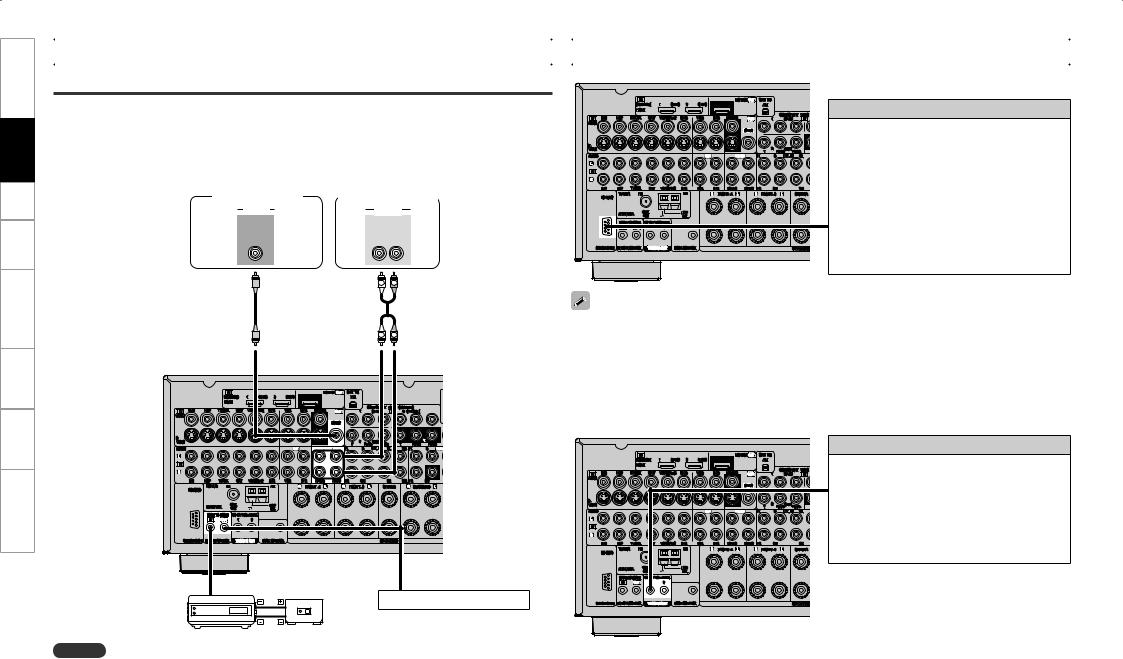
Troubleshooting Information Zone-Multi Control Remote Playback Setup Connections Started Getting
|
Multi-zone |
|
External Controller |
ZONE2 or ZONE3 Pre-out Connections
•If another power amplifier or pre-main (integrated) amplifier is connected, the ZONE2 or ZONE3 pre-out (variable or fixed level) connectors can be used to play a different program source in ZONE2 or ZONE3 the same time (vpage 57 ~ 60).
•When using an S-Video cable or a video cable for connection between the AVR-2808CI and an input device, connect to the video connectors.
•The ZONE2 video out is only for ZONE2.
Monitor (ZONE2) |
Power amplifier |
|
(ZONE2 or ZONE3) |
||
7*%&0 |
"6%*0 |
|
7*%&0 |
"6%*0 |
|
*/ |
|
*/ |
|
- |
3 |
|
L |
R |
RS-232C connector
This connector is used for an external controller.
bIf you wish to control the AVR-2808CI from an external controller using the RS-232C connector, perform the operation below beforehand.
q Turn om the AVR-2808CI’s power.
w Turn off the AVR-2808CI’s power from the external controller.
e Check that the AVR-2808CI is in the standby mode.
|
|
• When using in combination with an RF Remote Controller (RC-7000CI, sold separately) or RF Remote |
L |
R |
Receiver (RC-7001RCI, sold separately) two-way communication with an RF Remote Controller is |
|
|
possible. |
|
|
The AVR-2808CI’s status information as well as iPod can be browsed watching the RF Remote Controller’s |
|
|
display. For details, refer to the operating instructions of the respective devices. |
|
|
• When used in combination with an RF Remote Controller or RF Remote Receiver, make the settings at |
|
|
menu “Manual Setup” – “Option Setup” – “2Way Remote” – “Used” (vpage 32). |
|
|
Trigger output jacks |
|
|
The power of an external device equipped with |
|
|
a trigger input jack can be turned on and off in |
|
|
association with operations on the AVR-2808CI. |
|
|
For details, see menu “Manual Setup” – “Option |
|
|
Setup” – “Trigger Out” (vpage 32). |
|
|
• Output: DC 12 V 150 mA MAX. |
|
|
Check the trigger input conditions of the |
|
|
connected device. |
"69 |
Input |
Output |
|
065 |
|
||
|
Extension jack for future use. |
||
Infrared |
|
Infrared |
|
retransmitter |
|
sensor |
|
NOTE
•For the audio output, use high quality pin-plug cords so that no induction humming or noise is produced.
•For instructions on installing and operating separately sold devices, refer to the respective devices’ operating instructions.
•To conduct multi-zone playback, see “Amp Assign / Multi-zone Connections and Operations” (vpage 57 ~ 60).
19
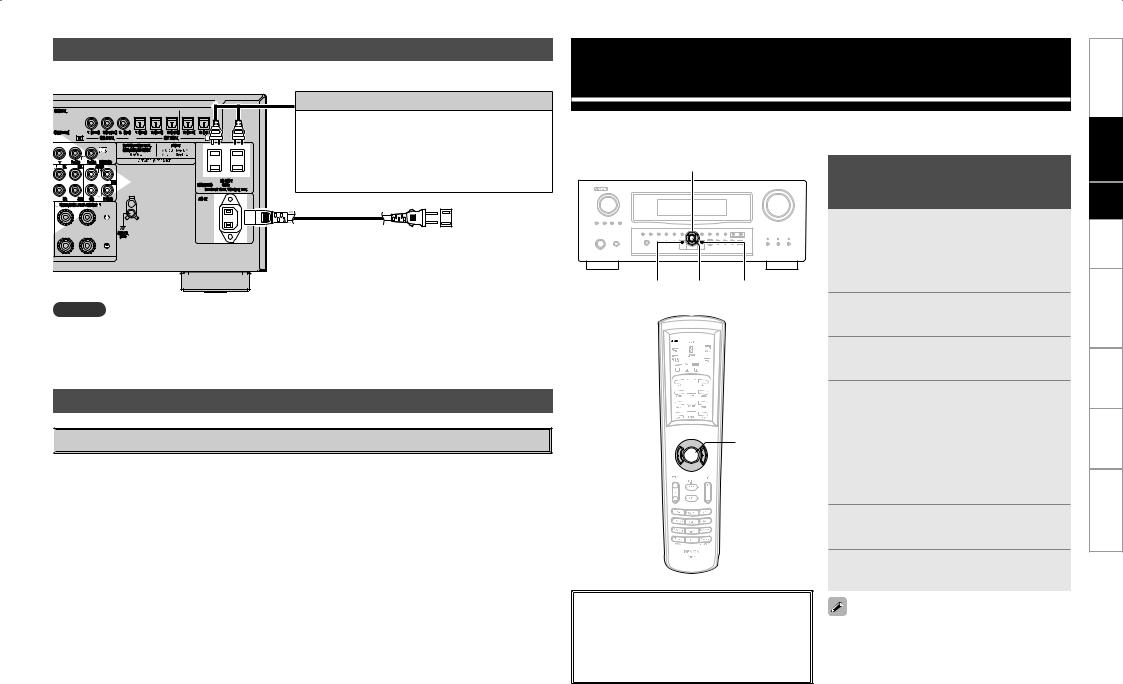
Connecting the Power Cord
Wait until all connections have been completed before connecting the power cord.
Connection to the AC outlets
• These outlets supply power to external audio devices.
• The power supplied from these outlets turns on and off together with the set’s power switch.
• Audio equipment with a total power consumption of 120 W (1 A) can be connected.
|
To household |
|
Power cord |
power outlet |
|
(AC 120 V, 60 Hz) |
||
(included) |
||
|
NOTE
•Insert the AC plugs securely. Incomplete connections could cause noise.
•Only use the AC outlets to plug in audio devices. Do not use them as power supplies for hairdryers or anything other than audio equipment.
Once Connections are Completed

 Turning the Power On (vpage 43)
Turning the Power On (vpage 43)
Menu Operations
With the AVR-2808CI, settings and operations for most functions can be performed by operating while looking at the menus displayed on the monitor screen.
uiop
MENU ENTER RETURN
[ AMP]
AMP] 





MENU 




 ENTER
ENTER



 uiop
uiop



 RETURN
RETURN
About the button names in these explanations
<> : Buttons on the main unit
[ ] : Buttons on the remote control unit
Button name only:
Buttons on the main unit and remote control unit
Operations
The same operation is possible on the main unit or remote control unit.
1Press MENU.
The menu is displayed.
b To operate from the main remote control unit, be sure to set the remote control unit to the AMP mode.
2Press uito select the item you want to set, then press ENTER.
3Press uiagain to select the item you want to set, then press ENTER.
4To change the setting:
Press uito select the item you want to change, then press o p to change the setting.
b To return to the previous item, press RETURN.
b Select “Default Yes”, then press o to reset to the default setting.
5Press ENTER to enter the setting.
6Press MENU to finish.
When MENU is pressed, the settings made up to that point are entered and the setting menu is cleared.
Troubleshooting Information Zone-Multi Control Remote Playback Setup Connections Started Getting
20
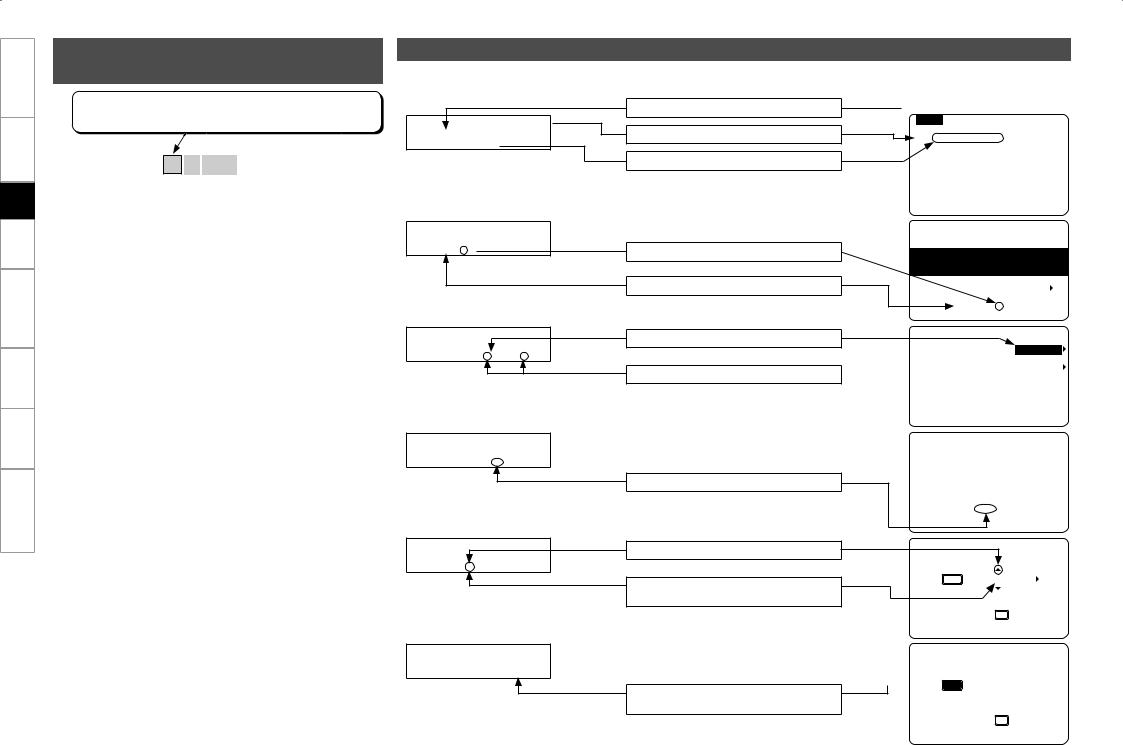
Troubleshooting Information Zone-Multi Control Remote Playback Setup Connections Started Getting
Example of Display of Default
Values
In lists of selectable items or adjustable ranges, the item surrounded by a border is the default value.
[Selectable items] A B A + B
Examples of On-screen Display and Front Display
Some typical examples are described below. GFront displayH
Q
*MENU
Auto Setup
*Start Menu
Start•
EQ
*Assign
Digital :•OPT1 –
WQE
*Distance
Unit:Meter•–Feet
*Rename:DVD •DV¡ –
*Rename:DVD Rename•– Clear
Screen title
Menu number
Submenu title
Press o to execute
Currently selected line
Current setting
Press op to change the setting
Press op to select one or the other
Use ui to input characters.
Use op to change the character input position.
When highlighted, press i to select “Default Yes”.
GOn-screen displayH

 MENU
MENU
 1.Auto Setup Manual Setup
1.Auto Setup Manual Setup
3.Input Setup 4.Parameter 5.Information
1-1.Start Menu
Step1:Speaker Detection Please place microphone at ear height at
main listening position.
Front Sp. A
A
Amp Assign
 Start
Start
Cancel
3-1.Assign
 Digital In :
Digital In : OPT1
OPT1
iPod Dock : None
None
2-1-3.Distance
Set The Distance To
Each Speakers
Do You Prefer
In Meters? / In Feet?
 Meters
Meters  :
: Feet
Feet
3-3.Rename
 DVD :
DVD : DV
DV
Default Yes 
3-3.Rename

 DVD :
DVD : DVD-3930
DVD-3930
Default Yes 

Menu Map
MENU
 1.Auto Setup
1.Auto Setup  2.Manual Setup
2.Manual Setup  3.Input Setup
3.Input Setup  4.Parameter
4.Parameter 
5.Information
Auto Setup (vpage 23 ~ 25)
n Start Menu |
n Option |
n Parameter Check |
• Step 1: Speaker Detection |
• Room EQ |
• Speaker Configuration Check |
• Step 2: Measurements |
• Direct Mode Setup |
• Distance Check |
• Step 3: Calculation |
• Mic Select |
• Channel Level Check |
• Step 4: Check |
|
• Crossover Frequency Check |
• Step 5: Store |
|
• EQ Check |
|
|
• Restore |
Information
(vpage 41, 42)
nStatus
•MAIN ZONE
•ZONE2/3
n Audio Input Signal
n HDMI Information
n Auto Surround Mode
n Quick Select
n Preset Station
NOTE
When “Screensaver” is set to “ON”, the screensaver is activated if no operation is performed for about 3 minutes.
When the uiop, ENTER or MENU button is pressed, the screensaver is canceled and the corresponding operation is performed.
Parameter
(vpage 38 ~ 41)
n Surround Parameter
•MODE
•CINEMA EQ
•D.COMP
•DRC
•LFE
•CENTER IMAGE
•PANORAMA
•DIMENSION
•CENTER WIDTH
•DELAYTIME
•EFFECT
•LEVEL
•ROOM SIZE
•AFDM
•SB CH OUT
•SUBWOOFER ATT.
•Subwoofer
•Default
n Tone Control
•Tone Defeat
•Bass
•Treble
n Room EQ n RESTORER n Night Mode n Audio Delay
Manual Setup (vpage 26 ~ 33)
|
n Speaker Setup (vpage 26, 27) |
n Zone Setup (vpage 30) |
n Option Setup (vpage 31 ~ 33) |
|
• Speaker Configuration |
• ZONE2 Setup |
• Amp Assign |
|
• Subwoofer Setup |
· Bass |
• Volume Control |
|
• Distance |
· Treble |
· Volume Limit |
|
• Channel Level |
· HPF |
· Power On Level |
|
• Crossover Frequency |
· Level Lch |
· Mute Level |
|
n HDMI Setup (vpage 27, 28) |
· Level Rch |
• Source Delete |
|
• HDMI Audio Setup |
· Channel |
• On-Screen Display |
|
· HDMI Audio Out |
· Volume Level |
· Screensaver |
|
· Auto Lipsync |
· Volume Limit |
· Text |
|
• HDMI Video Setup |
· Power On Level |
· Master Volume |
|
· i/p Scaler |
· Mute Level |
· Tuner Information |
|
· Resolution |
• ZONE3 Setup |
· iPod Information |
|
· Progressive Mode |
· Bass |
· Display Mode |
|
· Aspect |
· Treble |
• Quick Select Name |
|
· Color Space |
· HPF |
• Trigger Out |
|
· RGB Range |
· Level Lch |
• Remote ID Setup |
|
n Audio Setup (vpage 28, 29) |
· Level Rch |
• 2Way Remote |
|
• EXT. IN Subwoofer Level |
· Channel |
• Display |
|
• 2ch Direct/Stereo |
· Volume Level |
• Setup Lock |
|
• Dolby Digital Setup |
· Volume Limit |
|
|
• Auto Surround Mode |
· Power On Level |
|
|
• Manual EQ |
· Mute Level |
|
Input Setup (vpage 33 ~ 36) |
|
|
|
n TUNER (FM/AM) |
n PHONO |
n CD, DVD, HDP,TV/CBL, |
n XM |
• Auto Preset |
• Input Mode |
SAT,VCR, DVR, V.AUX |
• Preset Skip |
• Preset Skip |
• Rename |
• Assign |
• Antenna Aiming |
• Preset Name |
• Other |
• Input Mode |
• Input Mode |
• Input Mode |
· Video Select |
• Rename |
• Rename |
• Rename |
· Source Level |
• Other |
• Other |
• Other |
|
· Video Select |
· Video Select |
· Video Select |
|
· Video Convert (Excluding CDs) |
· Source Level |
· Source Level |
|
· Source Level |
|
|
|
• iPod |
|
Troubleshooting Information Zone-Multi Control Remote Playback Setup Connections Started Getting

Troubleshooting Information Zone-Multi Control Remote Playback Setup Connections Started Getting
Auto Setup
•This procedure lets you measure the acoustic properties of your speakers and listening room and make the optimum settings automatically.
•This function provides the optimum listening environment for all listening positions in a home theater where several people view or listen to the video or audio source simultaneously.
The measurements are performed by moving the setup microphone successively to the different positions where the family members sit within the listening area surrounded by the speakers, as shown in Example q. For better results, we recommend making measurements in 6 or more positions.
Even if the home theater is only used by a small number of persons as shown in Example w, measuring at points around the listening position results in more effective correction.
Example q |
Example w |
( :Measuring positions) |
|
*M |
*M |
About the main listening position (*M)
The main listening position refers to the center of the listening position, or the place where you would sit to watch or listen when alone.
This position is used as the basis when measuring the distance of the speakers.
To set the listening environment manually to suit your tastes, see page 26, 27.
Preparations
1Connect the included setup microphone to the SETUP MIC jack on the main unit.
The auto setup screen appears automatically.
Sound receptor
2Mount the setup microphone on a camera tripod, etc., and set it at the main listening position, with the sound receptor pointing towards the ceiling.
Setup
microphone








b Adjust the height of the setup microphone’s sound receptor so that it is at the height of the ears when listening.
When using a subwoofer with a setting function, make the following settings before starting the auto setup procedure:
•Volume: “Center”
•Crossover frequency: “Maximum”
•Low pass filter: “Off”
•Standby mode: “Off”
NOTE
•Do not disconnect the setup microphone until the auto setup procedure is completed.
•When using headphones, unplug the headphones before starting the auto setup procedure.
23

Auto Setup
Optimize settings for speakers in use.
F Menu screen F
1-1.Start Menu
Step1:Speaker Detection Please place microphone at ear height at
main listening position.
Front Sp. A
A
Amp Assign
 Start
Start
Cancel
aStart Menu
The settings are performed automatically.
Start
Start auto setup and output the test tone.
If an error message appears during the measurements, check “Error messages”, take the necessary countermeasures, then redo the measurements (vpage 25).
Set as desired before starting the auto setup procedure.
Front Speaker
The front speaker to be measured can be selected ahead of time here.
[Selectable items]
A: Output test tone from front speakers A.
B: Output test tone from front speakers B.
A + B : Output test tone from front speakers A and B.
Amp Assign
Advanced setting : changes power amplifier assignment. For details, refer to “Amp Assign” (vpage 31).
Step 1 : Speaker Detection
The speaker connection status and the speaker polarities are detected at the main listening position. At this time, the listening environment with respect to the main listening position (“Speaker size check”, “Distance correction”, “Channel level adjustment”, “Crossover frequency check” and “Room EQ correction”) is measured automatically at the main listening position.
Once the measurements are completed, the results of the speaker connection are displayed.
NOTE
•Loud test tones are output during the measurements. Be careful when measuring at night or when there are small children nearby.
•Do not stand between the speakers and setup microphone or allow obstacles between them while the measurements are being made. Obstacles will make it impossible to measure correctly.
•Keep as quiet as possible during measurements. Loud sounds in the area will make it impossible to measure correctly.
•Operating the MASTER VOLUME knob on the main unit or the VOL +/– buttons on the remote control unit during the measurements will cancel the measurements.
•Do not change the speaker connections or subwoofer volume after “Step 1”.
Step 2 : Measurements
The listening environment with respect to the listening position (“Speaker size check”, “Crossover Frequency check” and “Room EQ correction”) is measured automatically at positions 2 to 8.
Once a measurement is made, move the setup microphone to the next position.
Measure a total of at least 6 positions (main listening position and at least 5 other surrounding positions). Measurements can be completed even if only taken in 5 positions, but for better results we recommend taking them in 6 or more positions. (Measurements can be taken in a maximum of 8 positions.)
Step 3 : Calculation
When “Calculate” is selected at “Step 2”, the speaker system is analyzed automatically.
The time required for this analysis depends on the number of speakers connected. The more the number of speakers, the longer the time required for analysis.
Step 4 : Check
Once the auto setup procedure is completed, a measuring result checking screen appears.
Select any item whose measuring results you want to check and check the results.
Values that are different from the actual distance may be set for speakers with built-in filters (subwoofers, etc.).
Step 5 : Store
The auto setup measurement results are stored.
NOTE
Do not turn the power off while the settings are being stored in the memory.
Troubleshooting Information Zone-Multi Control Remote Playback Setup Connections Started Getting
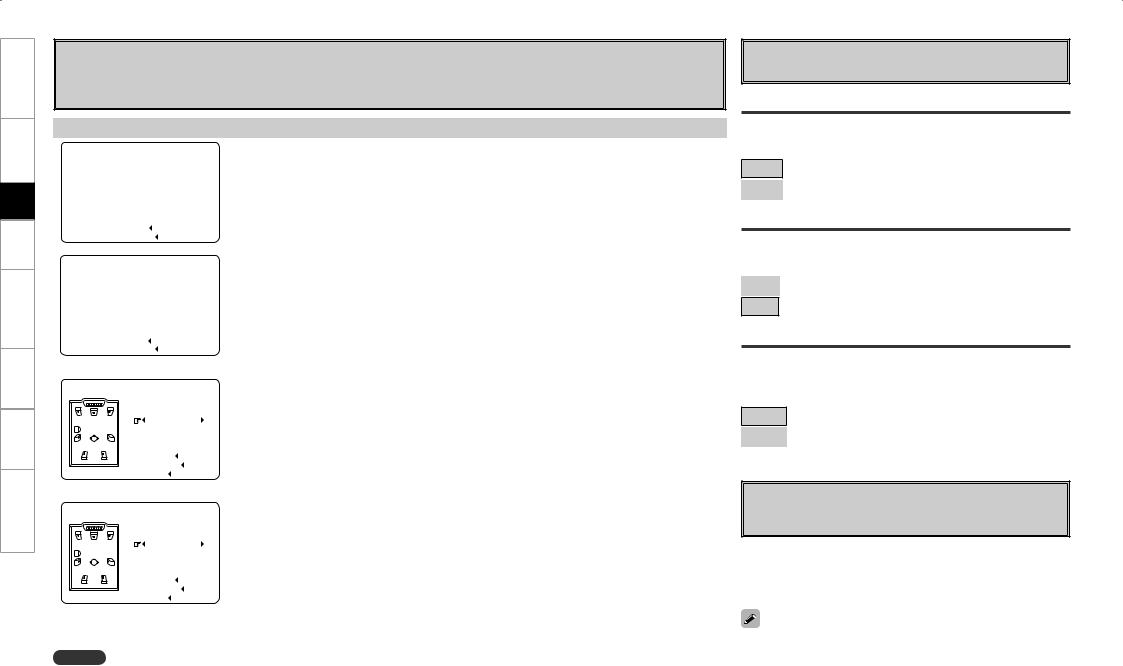
Troubleshooting Information Zone-Multi Control Remote Playback Setup Connections Started Getting
Error Messages
If the auto setup procedure could not be completed due to speaker installation, the measuring environment, etc., an error message is displayed. If this happens, check the relevant items, be sure to take the necessary measures, then perform the auto setup procedure over again.
|
Error messages (examples) |
|
Cause |
|
|
|
Measures |
|
||||||||||||||||
|
|
|
|
|
|
|
|
|
|
|
|
|
|
|
|
|
|
|
||||||
|
|
|
|
Auto Setup |
• Included setup microphone is not connected. |
• Connect the included setup microphone to the SETUP |
||||||||||||||||||
|
|
|
|
|
|
|
Caution! |
|
|
|
|
|
|
|
|
|
|
|
MIC jack on the main unit. |
|
||||
|
|
|
|
|
|
|
|
|
|
|
|
|||||||||||||
|
|
|
|
|
|
|
|
|
|
|
|
|
|
|
|
|
• Not all speakers could be detected. |
|
|
• Check the speaker connections. |
|
|||
|
|
|
Microphone:None |
|
|
|
||||||||||||||||||
|
|
|
|
|
|
|
or |
|
|
|
|
|
|
|
|
|
||||||||
|
|
|
Speaker |
|
:None |
|
|
|
|
|
|
|
|
|
||||||||||
|
|
|
|
|
|
Retry |
|
|
|
|
|
|
|
|
||||||||||
|
|
|
|
|
|
Cancel |
|
|
|
|
|
|
|
|
||||||||||
|
|
|
|
|
|
|
|
|
|
|
|
|
|
|
|
|
|
|
|
|
|
|
||
|
|
|
|
Auto Setup |
• Too much |
noise in |
the room |
for |
accurate |
• Either turn off any device generating noise or move it |
||||||||||||||
|
|
|
|
|
|
Caution! |
|
|
|
|
measurements to be made. |
|
|
|
away. |
|
||||||||
|
|
|
|
|
|
|
|
|||||||||||||||||
|
|
|
|
|
|
|
|
|
|
|
|
|
|
|
|
|
|
|
|
• Try again when the surroundings are quiet. |
|
|||
|
|
|
Ambient noise is |
|
|
|
|
|
|
|
||||||||||||||
|
|
|
too high or |
|
• Speaker or |
subwoofer sound is |
too |
low |
for |
• Check the speaker installation and the direction |
in |
|||||||||||||
|
|
|
Level is too low. |
|
accurate measurements to be made. |
|
|
which the speakers are facing. |
|
|||||||||||||||
|
|
|
|
|
|
|
|
|
|
|
|
|
|
|
|
|
|
|
|
|||||
|
|
|
|
|
|
|
|
|
|
|
|
|
|
|
|
|
|
|
|
|
|
|
• Adjust the subwoofer’s volume. |
|
|
|
|
|
|
Retry |
|
|
|
|
|
|
|
|
|||||||||||
|
|
|
|
|
Cancel |
|
|
|
|
|
|
|
|
|||||||||||
|
|
|
|
|
|
|
|
|
|
|
|
|
|
|
|
|
|
|
|
|
||||
|
|
|
|
|
|
|
|
|
|
|
|
|
|
|
|
|
• Displayed speaker could not be detected. |
|
• Check the connections of the displayed speaker. |
|
||||
|
|
|
|
Auto Setup |
· The front L and front R speakers were not |
|
|
|||||||||||||||||
|
|
|
|
|
|
|
|
|
|
|
|
|
|
|
|
|
properly detected. |
|
|
|
|
|
|
|
|
|
|
|
|
|
|
|
Caution! |
|
|
|
|
|
|
|
|
|
|
|
|||||
|
|
|
|
|
|
|
|
|
|
|
|
|
· Only one channel of the surround speakers |
|
|
|||||||||
|
|
|
|
|
|
|
|
|
Front |
|
|
|||||||||||||
|
|
|
|
|
|
|
|
|
was detected. |
|
|
|
|
|
|
|||||||||
|
|
|
|
|
|
|
|
|
|
|
· Sound was output from the R channel |
|
|
|||||||||||
|
|
|
|
|
|
|
|
|
L :None |
|
|
|
|
|||||||||||
|
|
|
|
|
|
|
|
|
|
|
|
|
|
|
||||||||||
|
|
|
|
|
|
|
|
Retry |
when only one surround back speaker was |
|
|
|||||||||||||
|
|
|
|
|
|
|
|
connected. |
|
|
|
|
|
|
||||||||||
|
|
|
|
|
|
|
|
Cancel |
|
|
|
|
|
|
||||||||||
|
|
|
|
|
|
|
|
Skip |
· The surround back, but the surround speaker |
|
|
|||||||||||||
|
|
|
|
|
|
|
|
|
|
|
|
|
|
|
|
|
was not detected. |
|
|
|
|
|
|
|
|
|
|
|
Auto Setup |
• Displayed |
speaker |
connected |
with |
the |
• Check the polarities of the displayed speaker. |
|
|||||||||||||
|
|
|
|
polarities reversed. |
|
|
|
|
• For some speakers, this error message may |
be |
||||||||||||||
|
|
|
|
|
|
|
|
|
|
|
|
|
|
|
|
|
|
|
|
|
||||
|
|
|
|
|
|
|
|
Caution! |
|
|
|
|
|
|
|
|
displayed even if the speaker is properly connected. In |
|||||||
|
|
|
|
|
|
|
|
|
|
|
|
|
|
|
|
|
|
|
||||||
|
|
|
|
|
|
|
|
|
|
|
|
|
|
|
|
|
|
|
|
|
|
|
||
|
|
|
|
|
|
|
|
|
Front |
|
|
|
|
|
|
this case, select “Skip”. |
|
|||||||
|
|
|
|
|
|
|
|
|
|
|
|
|
|
|
|
|
|
|||||||
|
|
|
|
|
|
|
|
|
L :Phase |
|
|
|
|
|
|
|
|
|
||||||
|
|
|
|
|
|
|
|
|
|
|
|
|
|
|
|
|
|
|
|
|||||
|
|
|
|
|
|
|
|
Retry |
|
|
|
|
|
|
|
|
||||||||
|
|
|
|
|
|
|
|
Cancel |
|
|
|
|
|
|
|
|
||||||||
|
|
|
|
|
|
|
|
Skip |
|
|
|
|
|
|
|
|
||||||||
|
|
|
|
|
|
|
|
|
|
|
|
|
|
|
|
|
|
|
|
|
|
|
|
|
 Select “Retry” to make the measurements again.
Select “Retry” to make the measurements again.
NOTE Be sure to turn the power off before checking the speaker connections.
sOption
Select settings for room EQ, mic, etc.
Room EQ
Select room EQ setting method.
[Selectable items]
All : Apply settings to all surround modes.
Assign : Make settings for each surround mode separately.
Direct Mode Setup
Select room EQ use for DIRECT or PURE DIRECT mode.
[Selectable items]
ON : Use room EQ.
OFF : Do not use room EQ.
Mic Select
Select the microphone type if not using supplied mic. The microphone connected to V.AUX Lch is used.
[Selectable items]
Mic : Supplied mic is being used.
V.AUX L : Other mic connected to V.AUX is used.
dParameter Check
Check auto setup measurement results.
This is displayed after the auto setup procedure is completed.
[Items to be checked] |
|
|
|
|
||
|
|
|
|
|
|
|
Speaker Config. Check |
|
Distance Check |
|
Channel Level Check |
||
|
|
|
|
|||
Crossover Freq. Check |
|
|
EQ Check |
|
||
|
|
|
|
|
|
|
The auto setup results can be set again when “Restore” is selected.
25
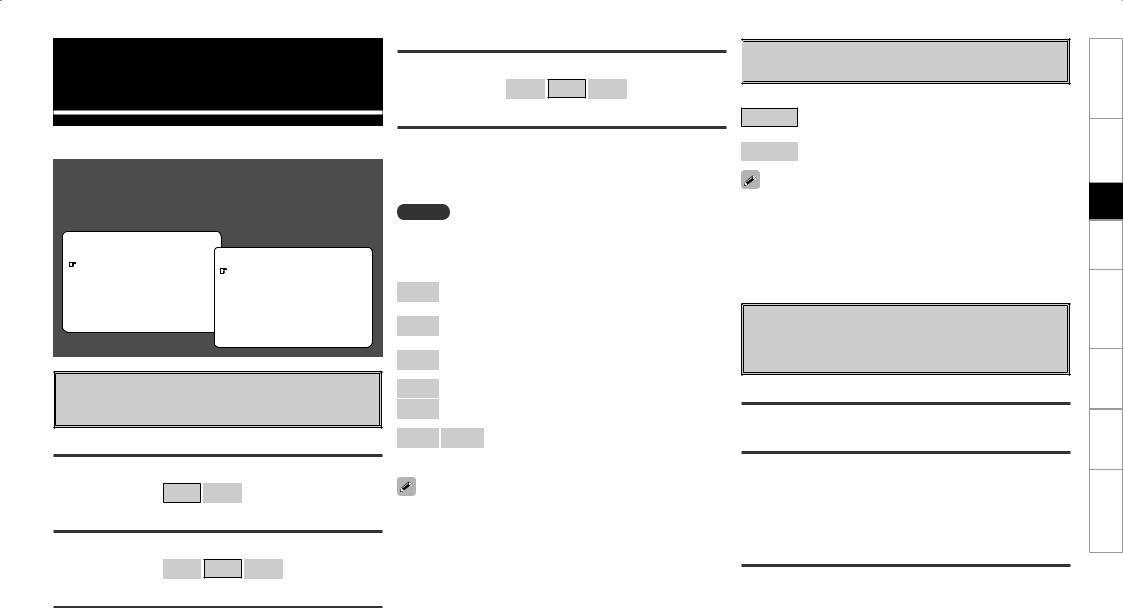
Manual Setup
Make detail settings for various parameters.
Speaker Setup
Use this procedure to set the speakers manually or if you wish to change the settings made with the auto setup procedure.
F Menu screen F
MENU |
|
|
1.Auto Setup |
2.Manual Setup |
|
2.Manual Setup |
1.Speaker Setup |
|
3.Input Setup |
||
4.Parameter |
2.HDMI Setup |
|
5.Information |
3.Audio Setup |
|
|
|
4.Zone Setup |
|
|
5.Option Setup |
aSpeaker Configuration
Select speaker configuration and size. (bass reproduction capability)
Front Speaker
Select front speaker size.
[Selectable items] Large Small
Center Speaker
Select center speaker use and size.
[Selectable items] Large Small None
Subwoofer
Select subwoofer use.
[Selectable items] |
Yes |
|
No |
Surround Speaker
Select surround speakers use and size.
[Selectable items] Large Small None
Surround Back Speaker
Select surround back speaker use and size.
[Selectable items] ( |
|
|
|
|
|
|
) |
Large |
|
|
Small |
|
None |
||
( |
|
|
|
|
|
) |
|
2spkrs |
|
|
1spkr |
|
|
NOTE
By default, the AVR-2808CI’s “Amp Assign” setting is set to “ZONE2”. To use as the surround back speaker for the main zone, change the “Amp Assign” setting (vpage 31).
Large :Select this when using large speakers with ample low frequency reproduction capabilities.
Small :Select this when using small speakers without ample low frequency reproduction capabilities.
None :Select this when no speaker is connected.
Yes :Select this when a subwoofer is connected.
No :Select this when no subwoofer is connected.
2spkrs 1spkr :
Select the number of surround back speakers.
•Select “Large” or “Small” not according to the physical size of the speaker but according to the low frequency reproduction capabilities based on the frequency set at “Crossover Frequency” (vpage 27).
•When “Front Speaker” is set to “Small”, “Subwoofer” is automatically set to “Yes”.
•If “Subwoofer” is set to “No”, “Front Speaker” is automatically set to “Large”.
•If “Surround Speaker” is set to “None”, “Surround Back Speaker” are automatically set to “None”.
•When using just one surround back speaker, connect it to the left channel (SBL).

 sSubwoofer Setup
sSubwoofer Setup
Select low range signal to be reproduced by subwoofer.
[Selectable items]
LFE : Play low range and LFE signal of channels set to “Small”.
LFE+Main : Play low range and LFE signal of all channels.
•This can be set when menu “Speaker Configuration” – “Subwoofer” is set to “Yes”.
•Play music or a movie source and select the mode offering the strongest bass.
•Select “LFE+Main” if you want the bass signals to always be produced from the subwoofer.
dDistance
Set distance from listening position to speakers.
Before making the settings, measure the distance from the listening position to the different speakers.
Feet / Meters
Select unit for distance.
Step
Select step. (smallest distance)
[Selectable items]
1ft |
|
0.1ft |
: Can be selected when “Feet” is set. |
|
|
|
|
0.1m |
|
0.01m |
: Can be selected when “Meters” is set. |
|
|
|
|
Default
Resets the settings to the default values.
Troubleshooting Information Zone-Multi Control Remote Playback Setup Connections Started Getting
26
